
THE VOICE OF ONTARIO DAIRY PRODUCERS THE SUPPLY CHAIN From Dairy Farms to Dairy Processors FEBRUARY 2024 40063866 Publications Mail Sales Agreement No Giving back is a way of life for Don Johnston of Cherry Crest Holsteins LIFETIME ACHIEVEMENT AWARD
SUBSCRIPTIONS
For
MILK
Mississauga, ON L5N 2L8
Phone: (905) 821-8970
Fax: (905) 821-3160
Email: milkproducer@milk.org
Opinions expressed herein are those of the author and/or editor and do not necessarily reflect the opinion or policies of Dairy Farmers of Ontario. Publication of advertisements does not constitute endorsement or approval by Milk Producer or Dairy Farmers of Ontario of products or services advertised.
Milk Producer welcomes letters to the editor about magazine content.
*All marks owned by Dairy Farmers of Ontario.
WEBSITES
Facebook:
X: @OntarioDairy
Instagram: @OntarioDairy
LinkedIn: dairy-farmers-of-ontario



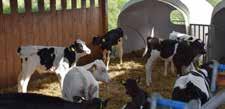
CON TENTS 3 WWW.MILKPRODUCER.CA • JANUARY 2024 • February 2024 | Vol. 100 No. 2 PUBLISHED BY DAIRY FARMERS OF ONTARIO 6780 Campobello Road Mississauga, ON L5N 2L8 MANAGER, COMMUNICATIONS
sharon.laidlaw@milk.org ADVERTISING
Sharon Laidlaw
pat.logan@milk.org
DESIGN Katrina
CONTRIBUTORS
Consulting, Andrew Brooks, Ryan Dick, Katie Duncan, Essi Evans, Luke Heider, Rebecca Hannam, Chris McCullough Jeanine Moyer, Pedro Nogueira, Robert Price, Theresa Rogers, Javier Sanchez, Lilian Schaer, Brittany
Post Publications Mail Sales Product Agreement No.40063866.
postage guaranteed. Circulation: 8,000.
0030-3038. Printed in Canada.
Pat Logan
519-788-1559 GRAPHIC
Teimo
ACER
Wood Canada
Return
ISSN
subscription changes or to unsubscribe, contact:
PRODUCER
6780 Campobello Road
SOCIAL
www.milkproducer.ca www.milk.org
&
MEDIA
/OntarioDairy
16 Giving back is a way of life for Don Johnston of Cherry Crest Holsteins ON THE COVER THE SUPPLY CHAIN 6 Enhanced Lab Services Boosts On-farm Quality Control 8 Antimicrobial use on Canadian Dairy Farms 18 Hazard Assessments Can Ensure Third Party Safety 22 Emma Morrison is the Face of Many On-farm Dairy Research Projects 24 From West to East: Ideas on Feed Practices 27 An Effective Supply Chain Delivers Training as well as State-Of-The-Art Equipment 30 Managing for Better Calf Immunity 33 Milk Transporters are an Essential Link in the Supply Chain DEPARTMENTS 4 Board Editorial 11 Dairynomics 46 Back40 LIFETIME ACHIEVEMENT AWARD 37 Recommendations for Developing an Ontario Path Forward for Deadstock WORLD DAIRY 40 Young German Dairy Farmer Secures Income from Milk, Beef and Manure
FROM DAIRY FARMS TO DAIRY PROCESSORS
BY Albert Fledderus , BOARD MEMBER REGION 7 — BRANT, HALDIMAND, HALTON, NIAGARA, NORFOLK AND WENTWORTH
In this month’s issue of Milk Producer, we’re highlighting important steps within the dairy supply chain to showcase the journey that Ontario milk makes from dairy farms to dairy processors.
As the regulator and sole delegated authority for the marketing of milk in Ontario, an essential part of Dairy Farmers of Ontario’s (DFO) mandate is to ensure quality milk from dairy farms is sent to dairy processors— ultimately for consumers to enjoy the dairy products they love.
By the numbers: in 2023, more than 100,000 truckloads of milk made their way to 87 plants for processing across our province. Broken down, there are 227 milk trucks and over 600
drivers we entrust to pick up and deliver milk from 3,213 Ontario farms. Drivers navigate through a total of 580 routes with 276 loads per day. This amounted to more than 3.1 billion litres of milk produced and delivered to processors last year.
Our drivers do more than transport milk—they are highly valued industry experts. Each driver must successfully complete and pass a bulk tank milk graders (BTMG) course which provides them with important milk quality responsibilities.
In addition to regulatory requirement enforcement, DFO’s focus on high quality milk includes giving producers the support they need to meet and exceed those standards.
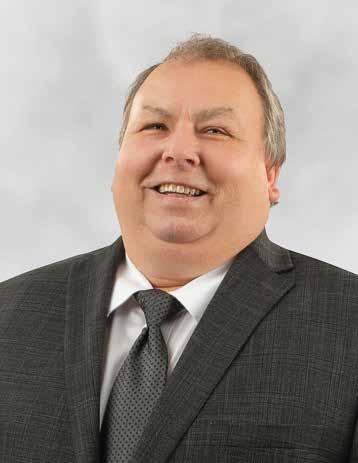
Beginning March 1, we are enhancing testing, and all producer samples will be tested for both composition and bacteria. Increased testing means producers can identify issues sooner and better manage their farms. Having access to more data points will also enhance DFO’s monitoring capabilities at the load and provincial levels thereby improving overall milk quality.
Throughout the supply chain DFO takes vital steps to ensure quality milk from dairy farms is provided to dairy processors for transformation into the dairy products consumers know and love. It all starts on the farm!





• FEBRUARY 2024 • WWW.MILKPRODUCER.CA 4
Albert Fledderus
Farms for Sale MANITOBA Sheldon Froese • 204.371.5131 sheldonfroese@royallepage.ca www.farmdivision.ca To view more farms for sale, visit: Dairy Farm D 16494 • Newer 4 robot barn • 285 kgs quota • Excellent location Dairy Farm D 16543 • Starter dairy • 475.09 acres • 65 kgs quota Call for your confidential, no obligation market evaluation in MB & SK and non-advertised listings. Quota available monthly for purchase through DFM exchange. Dairy Farm D 17130 • 5 Lely A5 robots • 295.56 kgs quota • 313.89 acres, more available
BOARD EDITORIAL
Just released & available to everyone:
724HO02033
Benbie ALLURE PP A2A2/AB
#1


724HO02004
The ONLY Proven Bull
or Higher With Over +100 Kg Fat

 JEANLU A2P2 GLORY (VG-87 2yr)
Valiant Dairy Genetics, ON
ROSE VEGA A2P2 JIANNA (VG-86 2yr)
Rose Vega Farm, ON
JEANLU A2P2 GLORY (VG-87 2yr)
Valiant Dairy Genetics, ON
BOKMA A2P2 DIXIE (VG-86 1yr)
JEANLU A2P2 GLORY (VG-87 2yr)
Valiant Dairy Genetics, ON
ROSE VEGA A2P2 JIANNA (VG-86 2yr)
Rose Vega Farm, ON
JEANLU A2P2 GLORY (VG-87 2yr)
Valiant Dairy Genetics, ON
BOKMA A2P2 DIXIE (VG-86 1yr)
Contact for International Semen Marketing dave@validitytesting.com • 905-866-7800 Available in Canada from Dec. ‘23 Proof A2P2 PP Conformation Mammary Feet & Legs Dairy Strength Rump kg Fat % Fat 12 9 7 7 12 +107 kg +0.90
A2P2-PP (EX)
Bokma Farms, NS
VOGUE
CANM13446574 A2A2 / AB
x 87 5* DUKE x 86 2* POWERBALL aAa 315246 A2P2 PP...Customer Satisfaction and Profitability!
LUSTER-P
A2P2
GPA-LPI A2A2
Son +3593 GLPI
+12 Conf

ENHANCED LAB SERVICES BOOSTS ONFARM QUALITY CONTROL
By Jeanine Moyer
MARCH 1, 2024, marks another major milestone in milk quality assurance for Ontario dairy farmers when raw milk testing will move from five to seven days a week. All producer samples will be tested for both composition and bacteria.
“Enhanced testing is being initiated as part of our goal to provide producers with timely quality results, and to provide our customers with the highest quality milk that goes into the dairy products Ontarians enjoy every day,” says Alex Hamilton, Dairy Farmers of Ontario’s (DFO) director of regulatory compliance and quality assurance.
The new, enhanced service is the next logical step in the evolution of milk testing services in Ontario. Originally, producers received one
“We are excited to announce the introduction of enhanced sample testing in the Ontario dairy industry. This development marks a significant advancement in our industry as we strive to provide our dairy farmers with improved testing and reporting frequency.”
– Gagandeep Khinday, DFO manager, measurement and technical support.
bacteria test per month. This was increased to the current frequency of one test per week. Testing each shipment will increase the number of bacteria results for producers to 15 to 16 per month for an every-otherday shipper. As a result, with the Agriculture and Food Laboratory (AFL) working seven days a week, producers will see results more frequently and test results will now be posted on weekends as well.
Extending the lab schedule to seven days a week plays a critical role. Raw milk samples are tested using the latest BactoScan instruments based on flow cytometry technology. The lab results – composition, fat, protein, solids, somatic cell counts, milk urea nitrogen (MUN), Free Fatty Acid (FFA) and bacteria – are important for farmers to monitor, milk quality and manage production in a timely manner.
“We are excited to announce the introduction of enhanced sample testing in the Ontario dairy industry,” says Gagandeep Khinday, DFO’s manager, measurement and technical support. “This development marks a significant advancement in our industry as we strive to provide our dairy farmers with improved testing and reporting frequency.”
Through collaboration with logistics and testing partners, the expanded sample pickup and testing schedule will now include weekends, Khinday adds. The objective is to consistently deliver all sample results within a two-day timeframe throughout the year, except for statutory holidays. This initiative will further strengthen the sample
• FEBRUARY 2024 • WWW.MILKPRODUCER.CA 6 RESEARCH
While composition testing began in 1967, bacteria testing started in 1984 using the standard plate count. In 1994, a study was commissioned to evaluate emerging technology to provide more timely results to farmers.
cold chain and support all industry stakeholders in their efforts to maintain the highest standard of milk quality on a daily basis.
MILK TESTING IMPROVEMENTS
“Our lab is delighted to continue the partnership with DFO to provide the enhanced testing services with a streamlined and integrated process, testing all farm samples seven days a week and delivering the results to farmers on the same day as samples are received at the lab,” says Looknauth Ramsahoi, supervisor, dairy analysis, AFL.
The AFL, Laboratory Services Division at the University of Guelph, continues the tradition of the world’s first-ever automated and
computerized Central Milk Testing Laboratory (CMTL) that was established in 1967. While composition testing began in 1967, bacteria testing started in 1984 using the standard plate count. In 1994, a study was commissioned to evaluate emerging technology to provide more timely results to farmers. As a result, the lab was able to deliver same-day results upon receiving samples instead of over two days via plate count in 1998 and was the first lab to use the BactoScan instrument in North America. The rapid results allowed farmers to take timely actions to preserve and enhance milk quality. The technological change also allowed increased testing frequency from once a month in 1985 to once a week in 2010.
“The unmatched expertise and extensive experience in milk testing the AFL provides, along with its mature quality system, will continue to ensure timely and accurate testing results for Ontario dairy farmers with peace of mind,” says Kateryna Dmytrakova, DFO quality assurance program manager and production administrator.
WHAT’S NEXT?
The goal is to provide farmers with more consistent reporting for all test results. More data will allow better management on-farm. Any questions about this new testing schedule can be forwarded to your field services representative.




7 WWW.MILKPRODUCER.CA • FEBRUARY 2024 • SMART & RESPONSIBLE INNOVATION IN ANTIBIOTICS Ask your veterinarian for more information. © 2023 Ceva Animal Health Inc. Zeleris and Cevolution are registered trademarks of Ceva Santé Animale S.A. zeleris.ca Now available in a larger, 500 mL format! Easy dosage Easy to inject CLAS® (Ceva Layered Anti Shatter) vial Zeleris ad Half page Milk Producer.indd 1 1/8/24 2:11 PM
ANTIMICROBIAL USE ON CANADIAN DAIRY FARMS
By ACER Consulting, Javier Sanchez and Luke Heider
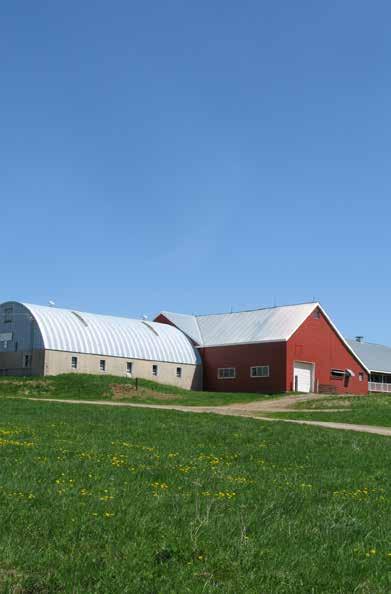
REDUCING ANTIMICROBIAL USE IN HUMANS AND ANIMALS
is critical to combating resistance to commonly used antimicrobial treatments. We all need to work together to meet this challenge and the dairy industry is taking action to do its part.
WHAT IS CADNETASR?
The Canadian Dairy Network for Antimicrobial Stewardship and Resistance (CaDNetASR) was created to address the critical knowledge gap in antimicrobial use (AMU) and resistance (AMR) on Canadian dairy farms under the Canadian Agricultural Partnership (Agriculture and Agri-Food Canada, Dairy Farmers of Canada and the Public Health Agency of Canada). The goal was to develop and implement an antimicrobial surveillance system to help understand AMU and AMR and improve antimicrobial stewardship.
From 2019 to 2022, data was collected on 144 dairy farms from five provinces to quantify herd-level AMU and detect herd-level AMR. This project included researchers from six Canadian universities (University of Prince Edward Island, University of Guelph, University of Saskatchewan, University of Montreal, University of Calgary and Memorial University), veterinary epidemiologists from the Public Health Agency of Canada, stakeholders from provincial and national producer organizations, veterinary organizations and dairy herd improvement organizations.
ANTIMICROBIAL USAGE ON DAIRY FARMS IN CANADA
For each participating dairy farm, researchers used discarded drug containers to calculate the defined daily dose (DDD) for each antimicrobial used to give a herd-level metric of AMU for comparison across farms. The DDD for each participating farm was calculated and compared across others in the sample to estimate antimicrobial usage. Drugs with the highest DDD were penicillin, firstgeneration cephalosporin, third-generation cephalosporin and tetracyclines.
When comparing AMU across various farms in this study, researchers saw a high amount of variability among participating farms, which suggests there is likely an opportunity for strategically reducing AMU on some Canadian dairy farms. Efforts will continue toward reducing AMU without compromising animal welfare and improve antimicrobial stewardship on dairy farms.
ON-FARM ANTIMICROBIAL RESISTANCE
Researchers assessed on-farm AMR by analyzing fecal samples and bulk tank milk samples from dairy farms. The CaDNetASR project aims to monitor foodborne pathogens, so a focus was placed on E. coli (generic strain), Campylobacter spp., and Salmonella spp.
For each participating dairy farm, researchers used discarded drug containers to calculate the defined daily dose (DDD) for each antimicrobial used to give a herd-level metric of AMU for comparison across farms.
• FEBRUARY 2024 • WWW.MILKPRODUCER.CA 8
RESEARCH
The generic, non-pathogenic strain of E. coli was the most commonly found bacteria on farms (present in 96 per cent of samples). E. coli was commonly found to be resistant to tetracycline, streptomycin and sulfisoxazole. Campylobacter spp. was less common than E. coli, but still widely present (present in 54 per cent of samples). Campylobacter spp. most commonly showed resistance to tetracycline, in addition to nalidixic acid and ciprofloxacin. Found in approximately seven per cent of all samples, Salmonella spp. showed resistance to tetracycline, sulfisoxazole and streptomycin.
Based on the results of this study:
1. Tetracyclines were some of the highest used antimicrobials across Canada;
2. E. coli (generic strain), Campylobacter spp. and Salmonella spp. are commonly found on Canadian dairy farms;
3. All three bacteria studied show resistance to tetracycline.
CALF HEALTH AND ANTIMICROBIAL USE
Calves are a target area for reduced AMU because they are commonly treated with antimicrobials, and they have a higher proportion of resistant and multidrug-resistant bacteria than older cattle. In this study, 30 per cent of calves were treated at least once with an antimicrobial, with most antimicrobial treatments due to respiratory disease and diarrhea.
Calves are a target area for reduced AMU because they are commonly treated with antimicrobials, and they have a higher proportion of resistant and multidrug-resistant bacteria than older cattle
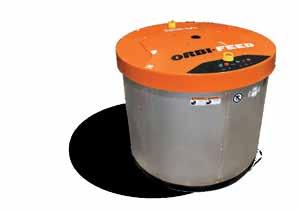
Farms that fed transition milk, i.e., milk produced between the second and sixth milkings following calving, gave fewer antimicrobial treatments than those that did not. Therefore, feeding transition milk may act as a management practice that could reduce disease and antimicrobial use.
TAKE-HOME MESSAGES
Antimicrobial use is an important challenge that needs to be addressed. AMU and AMR have been investigated on Canadian dairy farms; however, work in these areas will continue to determine the best strategies to reduce AMU. On dairy farms, antimicrobial use in calves could be an important area to focus on to reduce AMU. Work with your veterinarian to determine management practices to limit disease and antimicrobial use on your farm.
ACER Consulting is based in Guelph, Ont.; Javier Sanchez is a professor, and Luke Heider is assistant professor, Atlantic Veterinary College, University of Prince Edward Island.



9 WWW.MILKPRODUCER.CA • FEBRUARY 2024 •
CHANGE FOR THE BETTER.
“ This robot is more cow friendly. It’s wide open rather than being boxed in, and you can see when the cow comes in, she is more relaxed. Attachment times are smooth and fast, and I like that it is capable of draining individual quarters with any cow with high SCC. It does a great job prepping and cleaning the teat, as well as the coverage on the post dip. I also like that as soon as the exit gate opens, it closes the feed manger and out goes the cow without her waiting around eating feed. It’s an AMAZING machine! ”
Scott Colony transitioned from 5 competitor milking robots to 5 GEA DairyRobot R9500. George Wurz - Scott Colony, SK

BRITISH
Pacific Dairy Centre Ltd.
Chilliwack — 604 852-9020
ALBERTA
Dairy Lane Systems Alberta Leduc — 780 986-5600
Nobleford – 587-335-9742
Lethbridge Dairy Mart Ltd.
Lethbridge — 888 329-6202
SASKATCHEWAN
Dairy Lane Systems
Saskatchewan Warman — 306 242-5850
Emerald Park — 306 721-6844
MANITOBA
Tytech
Grand Pointe — 204 770-4898
ONTARIO
Conestogo Agri Systems Inc.
Alma — 519 638-3022
Dairy Lane Systems
Komoka — 519 666-1404
McCann Farm Automation Ltd.
Seeley’s Bay — 613 382-7411
Performance Dairy Centre Inc.
Embro — 519 423-9119
Wood’s Dairy Source
Keene 705 295-3247
ATLANTIC
Atlantic Dairy Tech, Inc.
AMS Sub-dealer for Sheehy Entreprises Ltd.
Charlottetown, PE — 902 368-1719
Sheehy Entreprises Ltd.
Shubenacadie, NS — 902 758-2002
Lower Queensbury, NB — 506 478-4878
Contact your local GEA dealer to learn more about GEA Automated Milking Systems
GEA DairyRobot R9500
BETTER TECHNOLOGY. BETTER SOLUTIONS. BETTER SERVICE.
COLOMBIA
Lawrence’s Dairy Supply Inc. Moose Creek — 6 13 538-2559 PROVINCES

P5 MESSAGE –INCENTIVE DAY FEBRUARY – CONVENTIONAL
By Constantin Urtilescu • MANAGER, GOVERNMENT RELATIONS
Due to a higher than usual market demand at the beginning of 2024, the P5 Boards announce one incentive day for the month of February, for conventional milk producers.
The P5 provincial boards’ primary objective is to continuously monitor the milk market situation and meet demand in the most optimal way and will continue to adapt production signals to address market changes, as required.
The following table summarizes the incentive days:
Conventional Organic
January, 2024
February, 2024 1
March, 2024
“Raw milk orders from processors in the P5 have been unusually strong
for the month of January and there is no indication at this point that this trend will not continue at least for the early part of the year ” says Patrice Dubé, Dairy Farmers of Ontario’s chief economics and policy development officer.
It is important to point out that the significant increase in the butterfat tests at the P5 farm level, since October 2023, has resulted in over 30 million litres less of milk compared to what was initially forecasted at the P5 level for the last three months of the calendar year. While dairy producers continue to produce at a level that allows them to meet the butterfat demand in the Canadian market, the reduction in milk volume represents a significant shift for processors that are looking for both butterfat and the solids-non-fat. It will be interesting to watch how the butterfat test will evolve in the coming year, especially after the new crop season.
On the market side, the early year reality is significantly different than what was observed at the end of the last calendar year. For example, in December 2023, the P5 demand has dropped by more than 10 per cent compared to the previous month, which has resulted in butter stocks reaching 27,363 tonnes, up from November by 2,613 tonnes. December butter stock levels are still higher than where they were in December 2022 by 6,489 tonnes.
Cheese stock levels for the month of December 2023 were at 96,759 tonnes, down 311 tonnes from November and slightly lower than where they were in December 2022.
For the 52-weeks ending December 2, 2023, sales for fluid milk, fluid cream, yogurt, ice cream, cheese and butter increased/decreased by -1.4, -2.2, 3.1, 1.6, 0.7 and -3.6 per cent, respectively, compared with December 3, 2022.
FEBRUARY 2024 • MONTHLY RETAIL MARKETS AND PRODUCTION REPORT •A FEBRUARY 2024
A monthly recap of markets and production trends in Canada and Ontario
CANADIAN REQUIREMENTS AND PRODUCTION
Canadian butterfat requirements in kilograms and actual butterfat production across the P10.
12-month production (in millions of kilograms)
12-month requirements (in millions of kilograms)
407.9
Canadian production has increased by 2.9 per cent over the previous 12 months, and requirements have increased by 1.7 per cent over the previous 12 months.
SOLIDS NON-FAT TO BUTTERFAT (SNF-BF) RATIO
This graph shows Ontario’s SNF-BF ratio for the last 12 months.
December 2023: 2.1251
NATIONAL RETAIL SALES
Average increase in retail sales for dairy products sold in Ontario and the dairy product’s share of the total market sales, including at hotels, restaurants and institutions.
• It is important to point out that the significant increase in the butterfat tests at the P5 farm level, since October 2023, has resulted in over 30 million litres less of milk compared to what was initially forecasted at the P5 level for the last three months of the calendar year.
• While dairy producers continue to produce at a level that allows them to meet the butterfat demand in the Canadian market, the reduction in milk volume represents a significant shift for processors that are looking for both butterfat and the solids-non-fat.
As of March 26, 2022
Yogurt
* Source: AC Nielsen & StatsCan
NOTE: There is a two-month lag in the national retail sales data.
• On the market side, the early year reality is significantly different than what was observed at the end of the last calendar year. For example, in December 2023, the P5 demand has dropped by more than 10 per cent compared to the previous month, which has resulted in butter stocks reaching 27,363 tonnes, up from November by 2,613 tonnes
• FEBRUARY 2024 • MONTHLY RETAIL MARKETS AND PRODUCTION REPORT B DAIRYNOMICS – MARKET UPDATE 2.10 2.15 2.20 2.25 2.30 2.35 Jan 2023 Feb 2023 March 2023 April 2023 May 2023 June 2023 July 2023 Aug 2023 Sept 2023 Oct 2023 Nov 2023 Dec 2023 950,000 1,000,000 1,050,000 1,100,000 1,150,000 1,200,000 1,250,000 1,300,000 1,350,000 Dec 2022 Jan 2023 Feb 2023 March 2023 April 2023 May 2023 June 2023 July 2023 Aug 2023 Sept 2023 Oct 2023 Nov 2023 Dec 2023
Butterfat (Daily kgs) Requirements Production JANUARY
HIGHLIGHTS 422.7
Ontario SNF:BF ratio
12 MONTHS ENDING DECEMBER 30, 2023 RETAIL SHARE OF TOTAL MARKET
milk -1.40% 81.50% Cream -2.30% 40.90% Cheese 1.80% 54.40% Butter -2.30% 57.60% Ice cream 1.70% 70.70%
Fluid
3.10% 94.40%
SNF:BF Ratio
ONTARIO UTILIZATION
Percentage of the total milk produced in Ontario that was used to produce dairy products.
December 2023
Fluid milk & cream
Yogurt & ice cream
Cheese
Butter & powders
Skimming
P10 UTILIZATION BY CLASS
For December 2023 (kg of butterfat/kg of solids non-fat)
*There is a two-month lag reporting these figures
Class 1a1 (includes Classes 1a2, 1a3, 1c and 1d for confidentiality reasons) Fluid milk and beverages
Class 1b Fluid creams Class 2a Yogurt, yogurt beverages, kefir and lassi
Class 2b4 (includes Classes 2b1, 2b2 and 2b3 for confidentiality reasons) Fresh dairy desserts, sour cream, milkshakes and sports nutrition drinks
Class 2b5 Ice cream and frozen yogurt
Class 3a1 Specialty cheese
Class 3a2 Cheese curds and fresh cheeses
Class 3b2 (includes Class 3b1 for confidentiality reasons) Cheddar cheese and aged cheddar
Class 3c1 Feta
Class 3c2 Asiago, Gouda, Havarti, Parmesan and Swiss
Class 3c4 (includes Classes 3c3 and 3c5 for confidentiality reasons) Brick, Colby, farmer’s, jack, Monterey jack, muenster, pizza cheese, pizza mozzarella and mozzarella other than what falls within 3d
Class 3c6 Paneer
Class 3d Mozzarella used strictly on fresh pizzas by establishments registered with the Canadian Dairy Commission
Class 4a Butter and powders
Class 4d (includes Classes 4b1, 4b2, 4c and 4m for confidentiality reasons) Concentrated milk for retail, losses and animal feed
Class 5a Cheese for further processing
Class 5b Non-cheese products for further processing
Class 5c Confectionery products
FEBRUARY 2024 • MONTHLY RETAIL MARKETS AND PRODUCTION REPORT •C DAIRYNOMICS – UTILIZATION UPDATE 31% 6% 29% 30% 4% 202312
Fluid Milk & Cream Yogurt and Ice Cream Cheese Butter & Powders Skim Milk Disposal
-5% 0% 5% 10% 15% 20% 25% 30% 35% 5c 5b 5a 4d 4a 3d 3c6 3c4 3c2 3c1 3b2 3a2 3a1 2b5 2b4 2a 1b 1a1 NOVEMBER 2023 DECEMBER 2023 12-MONTH AVERAGE Fluid milk & cream 32.0% 31.3% 29.7% Yogurt & ice cream 7.5% 5.8% 7.4% Cheese 30.1% 28.7% 29.0% Butter & powders 29.9% 29.9% 30.7% Skimming 0.4% 4.3% 3.1%
% Butterfat % Solids non-fat
% Revenue 26.32% 9.18% 4.49% 1.43% 1.01% 0.90% 4.79% 14.40% 0.63% 2.80% 8.05% 0.42% 3.44% 16.29% 2.03% 1.30% 2.01% 0.49%
ONTARIO MONTHLY PRODUCER AVERAGE GROSS BLEND PRICE
A total 3,203 producers sold milk to DFO in December compared with 3,264 a year earlier.
ONTARIO DEDUCTIONS, PER HL
For December 2023
December 2023: $ 95.30
* These figures are based on Ontario’s average composition for December 2023 of 4.3565 kg butterfat, 3.3224 kg protein and 5.9356 kg other solids, rounded to the nearest cent.
P5 AND WESTERN MILK POOL BLEND PRICES
The graph below shows the 12-month blend price for the P5 provinces and Western Milk Pool (WMP).
*There is a two-month lag reporting these figures
WMP: $89.31
P5: $89.08
U.S. CLASS PRICES
The January 2024 Class III Price, US$15.17 per hundredweight, is equivalent to C$46.18 per hectolitre. This equivalent is based on the exchange rate US$1 = C$ 1.3409 the exchange rate when the USDA announced the Class III Price.
The Class III Price is in $ US per hundredweight at 3.5 per cent butterfat. One hundredweight equals 0.44 hectolitres. Canadian Class 5a and Class 5b prices track U.S. prices set by the U.S. Department of Agriculture.
Source: USDA
* Newfoundland does not operate a monthly quota exchange. Quota is traded between producers.
** Quota cap price of $24,000 in effect in Prince Edward Island, New Brunswick, Ontario, Nova Scotia and Quebec.
Co-ordinated by Dairy Farmers of Ontario’s communications and economics divisions. Questions? Please email questions@milk.org.
STAY UP TO DATE!
Weekly Update email newsletter every Friday for Ontario dairy producers.
Milk Producer magazine is the voice of Ontario dairy producers. Subscribe for free or read online at www.milkproducer.ca.
Dairy Farmer Update provides updates with the monthly milk cheque.
Producer Dashboard , a secure platform behind your password on MMS that contains important news, updates and forms.
www.milk.org
Facebook: /OntarioDairy
Twitter: @OntarioDairy
Instagram: @OntarioDairy
LinkedIn: /company/Dairy-Farmers-of-Ontario
• FEBRUARY 2024 • MONTHLY RETAIL MARKETS AND PRODUCTION REPORT D DAIRYNOMICS – PRICES UPDATE $76 $78 $80 $82 $84 $86 $88 $90 $92 Jan 2023 Feb 2023 March 2023 April 2023 May 2023 June 2023 July 2023 Aug 2023 Sept 2023 Oct 2023 Nov 2023 Dec 2023
WMP blend price
blend
Blend price in $/hL
P5
price
*
Within quota Overquota DFO administration $0.675 $0.675 DFO research $0.050 $0.050 CanWest DHI $0.060 $0.060 Transportation $3.650 $3.650 Market expansion $1.400 $1.400 Total deductions $5.835 $5.835 Average total net $88.899 -$5.835
MONTHLY QUOTA PRICES ($/KG) JANUARY PRICES PROVINCE PRICE/KG AMOUNT WANTED/KG AMOUNT FOR SALE/KG AMOUNT PURCHASED/ Alberta $ 55,580 515.15 182.00 157.00 Saskatchewan $ 41,025 52.00 25.70 10.00 Manitoba $ 41,200 169.88 141.99 135.95 British Columbia $ 35,500 173.96 22.37 22.37 Ontario $ 24,000 23,190.52 437.21 437.09 Quebec $ 24,000 16,983.23 765.85 765.83 New Brunswick $ 24,000 302.20 2.00 2.00 PEI Nova Scotia $ 24,000 1418.58 92.49 92.49 No Clearing Price Established
$70 $75 $80 $85 $90 $95 $100 $105 Jan 2023 Feb 2023 March 2023 April 2023 May 2023 June 2023 July 2023 Aug 2023 Sept 2023 Oct 2023 Nov 2023 Dec 2023
Peace of mind with traceability
For Larenwood Farms, traceability is important to build public trust and ensure that our industry can thrive by providing protection, prosperity, and peace of mind. What does traceability mean to you?


It’s important to trace a disease event so we can stop an outbreak like mad cow and foot-and-mouth before it becomes a really major issue. ”
Chris McLaren, Larenwood Farms Milking 120 cows in Drumbo, Ontario
Check out the new DairyTrace website!

Meet dairy producers across Canada in our video series as they share why and how they implement traceability on their farm.

DairyTrace.ca • 1-866-55-TRACE (1-866-558-7223) • info@DairyTrace.ca
“
LIFETIME ACHIEVEMENT AWARD
Giving back is a way of life for Don Johnston of Cherry Crest Holsteins
By Andrew Brooks
A LOVE OF DAIRY FARMING CAME TO DONALD JOHNSTON THE USUAL WAY: from his family. But circumstances prevented the owner of Cherry Crest Holsteins, winner of this year’s Lifetime Achievement Award, from succeeding his parents in the business.
“I was brought up on a farm east of Ottawa,” Johnston says. “But my father had some health issues and was forced to sell the cows in 1962 and the family moved to Ottawa. Then when I was a teenager I’d work summers on my uncle’s farm. That’s where I got the farming bug.”
So getting into dairy farming was a question of starting from scratch. Johnston graduated from the University of Guelph in 1976 and worked for Eastern Breeders for three years. In 1979 he had the opportunity to buy a herd of cows and quota on a rented farm near Ottawa.
Soon his path took another turn.
“I met my wife Nancy during that time – at a cattle show, in fact. Her family farm was three hours away, which made for a long commute for dating while I was trying to farm at the same time,” Johnston recalls. “We decided we’d better get married soon or I was going to lose the business!”
That was in 1983. In 1984, Don and Nancy purchased a farm in Glengarry County and moved Cherry Crest Holsteins and its 30 cows to a new location in Martintown. Now they milk 130 cows on 400 acres of land.
Don and Nancy have two grown children. Their son Kevin is now the leader of the team at Cherry Crest. He and his wife Tammy have two young sons. Daughter Merina and her partner Matt live in Kingston, where Merina works for Scotiabank.
The award citation reads in part that the award is given in recognition of the nominee’s “commitment to the betterment of Ontario’s dairy

“I was really excited when I found out I was receiving this award. But no man is an island. Everything you do in life, there’s people there that support you and help you. Obviously family is a big part of it, but I also had a lot of people who helped me when I was young.”
industry” and “outstanding contributions to our dairy community.” Johnston, who has served on the Glengarry Dairy Producer Committee for a number of years, is careful to point out that the award reflects the support he has received from others over the years.
“I was really excited when I found out I was receiving this award. But no man is an island. Everything you do in life, there’s people there that support you and help you. Obviously family is a big part of it, but I also had a lot of people who helped me when I was young.”
In the same way that Don and Nancy received support, especially in their early years, they now strive to give support where an opportunity arises.
Dairy Cares for SD&G is one way they do it. It’s a charitable organization that raises funds to support local hospitals. As the award citation puts it, “the Dairy Cares for Stormont, Dundas and Glengarry event… exemplifies how Don has shown up for producers and his community consistently.”
Johnston helped found the charity, taking the example of Dairy Cares Wisconsin in the US. A committee was formed of extremely keen and committed dairy farmers and a gala was planned to raise funding. The event was supported tremendously by farmers, retired farmers and ag-related businesses, Johnston says. Some observers wondered if the goal of $100,000 was too optimistic; at the end of the evening they donated over $187,000 to three local hospitals.
• FEBRUARY 2024 • WWW.MILKPRODUCER.CA 16
“I’m optimistic, but we have to be willing to change as the world changes. If you look at some of the mainline, world-renowned businesses that stood still – where are they today? We have to be willing to adapt."
When asked about changes and challenges, Johnston says that dairy farming faces a lot of the same challenges that other sectors face, such as financing and labour, as well as trying to prod government policy in directions that will result in improvements in the dairy sector. But for Johnston one of the biggest changes has been the growing complexity of dairy farming.
“It used to be the guy that got up the earliest and worked all day was the most successful. Today you still have to work hard, but the business element is paramount. Most dairy farms turn over millions of dollars a year.
“We need to ensure that our younger producers have the financial and technological tools to allow them to be successful.”
Johnston is upbeat about the future of dairy farming. “I’m optimistic, but we have to be willing to change as the world changes. If you look at some of the mainline, world-renowned businesses that stood still – where are they today? We have to be willing to adapt.
“You get a feeling from the younger farmers you talk to that they have concerns, but I think they’re happy. There’s a lot of opportunities in this business.”

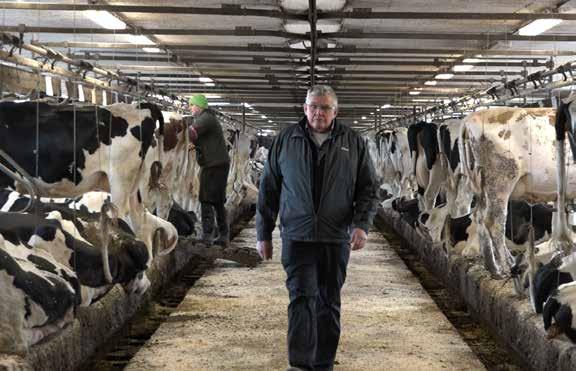

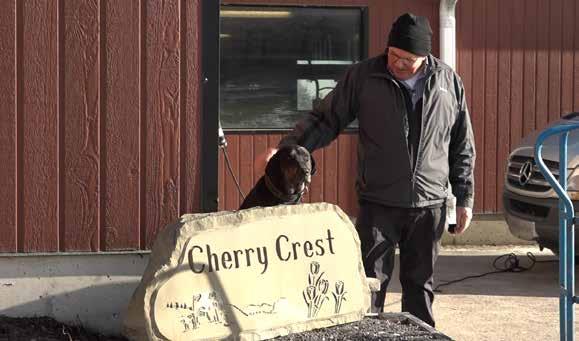
HAZARD ASSESSMENTS CAN ENSURE THIRD-PARTY SAFETY
By Ryan Dick
WHEN THE MILK AND FEED TRUCKS ROLL INTO THE YARD, are the drivers aware of the hazards around them? Do they know what controls are in place? If not, do they know where to get this information?
Many farm employers have completed hazard assessments focused solely on keeping their employees, buildings and equipment safe. However, as a facility owner, it is important to understand that you have a responsibility to
provide a safe work environment for any third-party workers on your premises too, such as the milk truck driver, feed delivery driver, veterinarian technician and custom operator.
The best way to ensure these parties are protected from onsite hazards is to revisit your hazard assessment and examine what tasks may put third-party workers at risk.
RACE
RACE (Recognize, Assess, Control, Evaluate) is an acronym often used when explaining how to conduct a hazard assessment and a widely accepted method for controlling hazards and reducing injuries and illness.
Here’s RACE in action:
STEP 1:
Recognize the hazard. Hazards can be grouped into one or more of the following six categories: physical, biological, chemical, psychological, safety and musculoskeletal disorders. Look at each of the outside party’s roles at your facility through the lens of these six categories.
For example, a feed truck driver may face biological hazards if they were to make contact with sick animals on-farm. In the winter, that same driver may be exposed




for over 20
At Brookturn Farms,


believe in being proactive not reactive. We use Udder Comfort on our fresh cows to ensure our cows are off to a great start to set the stage for a successful lactation. By using Udder Comfort, we are able to prevent problems and keep the milk owing into our bulk tank!



We believe our cows are like professional athletes – Brookturn Dempsey Pleasant EX-94 4E* Lifetime Production (6 lactations): 82508 KG3.9%F 3.4%P the perfect example! The kind of cow that will get any Dairyman excited! By putting cow comfort rst and using Udder Comfort it has been a contributing factor to sustaining great udder health. We breed for the kind of cow the lasts and improves our bottom line with ease and she does just that!
or go to link to read more about

• FEBRUARY 2024 • WWW.MILKPRODUCER.CA 18 FARM MANAGEMENT
“Our go-to for quality, comfort, peace of mind.”
have been
Udder
We
using
Comfort™
years.
we
Scan QR
https://wp.me/pb1wH7-k8 For external application to the udder only, after milking, as an essential component of udder management. Always wash and dry teats thoroughly before milking. 1.888.773.7153 1.613.652.9086 uddercomfort.com Call to locate a distributor near you. — Neil and Margaret Comfort BROOKTURN HOLSTEINS, The Comfort Family of St. Ann’s, Niagara County, Ontario with Brookturn Gold Chip Lacey- Grand Champion County Show 2023 & Best Udder. Neil and Margaret and son David (Shauna) and daughters Laura (Ryan) and Amanda (Brandon) Milking 64 Registered Holsteins, 11,700 kg M, F 410 kg, P 355 kg, 11 EX, 26 VG A step-by-step guide
Brookturn
to icy conditions, a hazard identified when looking at their role through the safety lens.
STEP 2:
Asses the risk level of each hazard.
When assessing risk level, probability and severity are the main factors to consider. How likely is it that a particular hazard will cause illness or injury? How severe of an outcome would it be?
In the example above, the likelihood of the delivery driver being exposed to zoonotic diseases is quite low when staying in the feed room. However, if the same driver needs to take feed to the other side of the barn through the pens, the likelihood of being exposed is higher. The severity, or how bad the injury or illness could be, would be the same for both examples, regardless.
STEP 3:
Control the hazards, especially ones assessed as high risk.
If you cannot eliminate the hazard completely, consider the most practical
administrative or engineered controls to reduce it.
For example, if feed is picked up by an employee instead of being delivered to the farm, the hazard of driver exposure would be eliminated. However, if this is not viable, you could put administrative controls in place to reduce the likelihood of biological exposure to delivery personnel, such as letting the feed company know drivers can’t go beyond the feed room and posting signs with this rule on the facility entrance doors.
STEP 4:
Evaluate the effectiveness of the controls.
Shortly after implementing controls, reassess the risk level of each hazard. The expectation is that it moves from high to moderate to low with the controls in place.
It’s recommended to reassess hazards on an annual basis or when materials or processes change. Using the example above, changing procedures so the feed driver does not enter the pens would reduce exposure risk from a high or moderate level, to a low level.
COMMUNICATE
Once you have completed the RACE
Once you have completed the RACE method of hazard assessment, it is important to communicate the findings and results to workers.
method of hazard assessment, it is important to communicate the findings and results to workers. In the case of external work parties, these risks can be communicated when contracting the services with the company, by posting signs and notices on-farm, or by having an employee verbally communicate the risks and controls when another party arrives.
USING RACE ON YOUR FARM
Make hazard assessments easy using the free hazard assessment tool available on WSPS. ca. The tool is both a guide and a place to document efforts.
By completing RACE and communicating the controls to both staff and third-party workers, you can ensure everyone is safe when they enter your facilities.
Ryan Dick is Health and Safety Consultant, Workplace Safety & Prevention Services (WSPS).
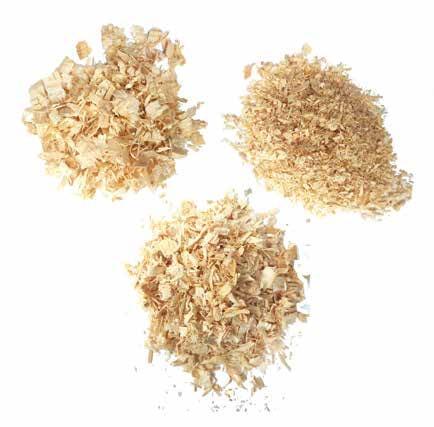
Quality Supplier of Premium Bulk and Bagged Shavings WOOD SHAVINGS INC. Premium Quality Shavings 1-800-350-8046 Walking Floor Trailers & Blower Trailer Loads Available for Delivery 1-800-350-8046 | email: sales@gmcfeeters.ca | Fulton, ON L0R 2A0 Canada 100% Natural Kiln Dried Softwood Shavings
There is no secret that we don’t already know.
We know exactly of what manure is made of. That’s why our equipment is designed to handle it in the most efficient way.
Our expertise is unmatched. Let our specialists and dealers advise you on a manure management plan made for your farm. Manure does not have any secrets from us.
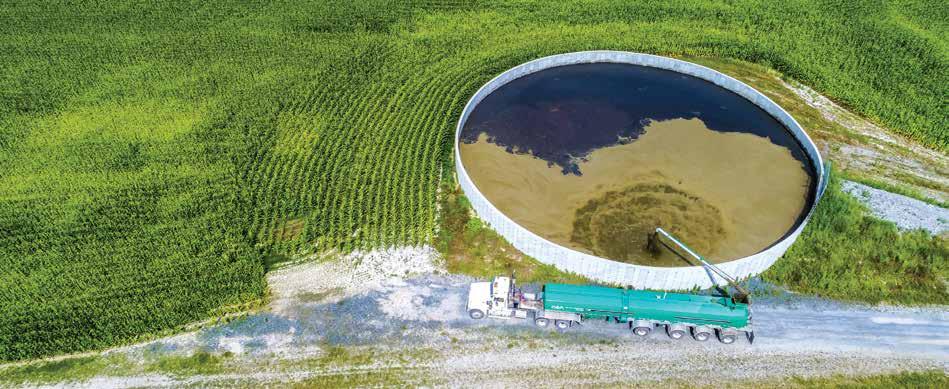
BRITISH COLUMBIA
Mountain View Electric Ltd.
Enderby — 250 838-6455
Pacific Dairy Centre Ltd.
Chilliwack — 604 852-9020
ALBERTA
Dairy Lane Systems
Leduc — 780 986-5600
Nobleford – 587-335-9742
Lethbridge Dairy Mart Ltd.
Lethbridge — 888 329-6202
SASKATCHEWAN
Dairy Lane Systems
Warman — 306 242-5850
Emerald Park — 306 721-6844
MANITOBA / NW ONTARIO
Penner Farm Services Ltd.
Blumenort — 204 326-3781
Thunder Bay ON – 800 461-9333
Tytech
Grande Pointe — 204 770-4898
ONTARIO
Claire Snoddon Farm Machinery
Sunderland — 705 357-3579
Conestogo Agri Systems Inc.
Drayton — 519 638-3022
1 800 461-3022
County Automation
Ameliasburg — 613 962-7474
Dairy Lane Systems
Komoka — 519 666-1404

Keith Siemon Farm Systems Ltd.
Walton — 519 345-2734
Lamers Silos Ltd.
Ingersoll — 519 485-4578
Lawrence’s Dairy Supply Inc.
Moose Creek — 613 538-2559
McCann Farm Automation Ltd.
Seeley’s Bay — 613 382-7411
Brockville — 613 926-2220
McLaren Systems
Cobden — 613 646-2062
Melbourne Farm Automation
Melbourne — 519 289-5256
Aylmer — 519 773-2740
Watford — 519-876-2420
Silver-Tech Systems Inc.
Dunnville — 905 981-2350

ATLANTIC PROVINCES
Atlantic Dairy Tech.
Charlottetown, PE — 902 368-1719
Mactaquac Farm Equip. Ltd.
Mactaquac, NB — 506 363-2340
Sheehy Enterprises Ltd.
Shubenacadie, NS — 902 758-2002
Sussex Farm Supplies
Sussex, NB — 506 433-1699

• FEBRUARY 2024 • WWW.MILKPRODUCER.CA 20 Learn more about GEA ProManure
Management
Manure
GEA Farming - Québec GEA Farming - Canada geafarming_ca GEA Farming Canada
ALWAYS INNOVATING ALWAYS EVOLVING ALWAYS FINDING
A BETTER WAY
FCC is proud to offer financing and knowledge to people with one eye on today and another on tomorrow. People like you.
FCC.CA
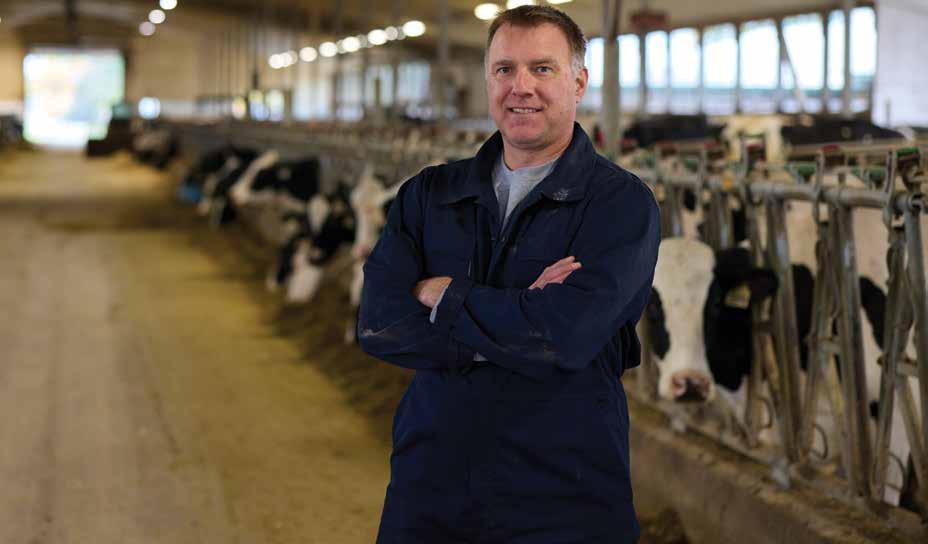

DREAM. GROW. THRIVE.
EMMA MORRISON IS THE FACE OF MANY ON-FARM DAIRY RESEARCH PROJECTS
By Katie Duncan, Photo Credit: Hanne Goetz
EMMA MORRISON IS A “JACK-OF-ALLTRADES” for dairy research at Ontario Veterinary College (OVC) and the face of many of Dairy at Guelphʼs on-farm studies and trials. As the lead dairy research technician and lab manager for the dairy health management research group at OVC, Morrison has the unique role of being everything, everywhere, all at once.
On any given day, Morrison’s work touches a large team of graduate students and postdocs working on dairy field research. She helps coordinate how research gets organized, leads the data collection process and lab work associated with each project and mentors new students on lab protocols and the techniques needed to collect data. When she’s not helping student-led research, she’s collecting data for additional projects that aren’t a part of graduate programs.
Most importantly, Morrison is a key contact for producers participating in research projects and the friendly face they meet during farm visits for research that ranges from a single visit to multiple visits per week over many months.
“I make a point of going on every first farm call to new herds so that I can meet the producers we are working with,” Morrison says. “It’s very important to me that our team makes a good impression and that we respect the producer, their herd and their time.”
Morrison started her education at the University of Guelph with a Bachelor of Science in Agriculture, majoring in Animal Science. Her dream originally was to pursue a Doctor of Veterinary Medicine degree at OVC, but she found an interest in research so she
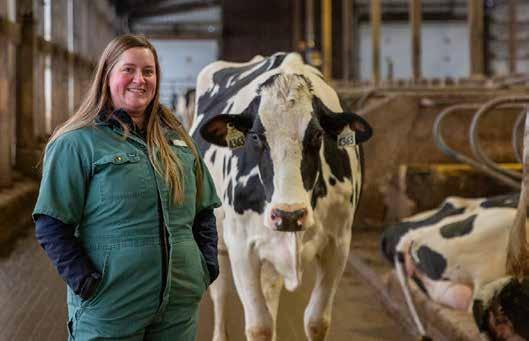
On any given day, Morrison’s work touches a large team of graduate students and postdocs working on dairy field research. She helps coordinate how research gets organized, leads the data collection process and lab work associated with each project and mentors new students on lab protocols and the techniques needed to collect data.
decided to pursue a master’s degree in epidemiology at OVC instead, working under Dr. Stephen LeBlanc, director of Dairy at Guelph and professor at OVC.
“I did not have a lot of dairy experience at the time, but Stephen welcomed me and I jumped in with both feet. After completing my master’s program, Dr. LeBlanc hired me part time, as his lab needed extra hands with a few projects that were on the go.”
It didn’t take long for Morrison’s role to snowball into a full-time role after seeing the value she brought to mentoring students and building relationships with producers. Now in the role for more than six years, Morrison loves the range of activities she gets to be a part of on any given day.
“A typical day starts between 5 and 7 a.m., heading out to farms where research is underway to collect samples and data or administer study treatments. Depending on the project, we could visit up to five or six farms a day.”
• FEBRUARY 2024 • WWW.MILKPRODUCER.CA 22 RESEARCH
In her proximity to the dairy industry, Morrison has grown to know and appreciate all the producers who have helped Dairy at Guelph researchers by allowing them on to their farms to collect data.

Before leaving the farm, the team leaves any cow-side results that could be valuable to the producer, such as BHB values which helps to determine if a cow is ketotic, or reproductive health results.
Once farm visits are completed and data is collected, it’s back to campus to process samples and clean and prepare for the next day.
“On a non-farm day, I spend most of the time in the lab organizing samples, running tests on samples already collected, data entry and helping graduate students with their research or providing feedback and advice.”
In her proximity to the dairy industry, Morrison has grown to know and appreciate all the producers who have helped Dairy at Guelph researchers by allowing them on to their farms to collect data.
“I really enjoy getting to see many different farm operations and how they manage, grow and improve their herd,” Morrison explains. “It is always exciting to see producers who are excited about big milestones, whether it be putting in robots, having a great classifier visit, or even putting in an on-farm dairy to process milk.”
She adds, “These projects have allowed me to know many of the producers and herd managers on a personal level, and by working together on research, our team at OVC is able to give them information about their herd that will benefit their production and overall herd health.”
Katie Duncan is Communications Officer, Ontario Veterinary College, University of Guelph.
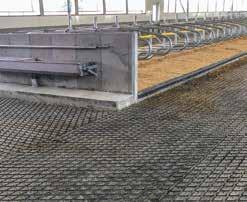
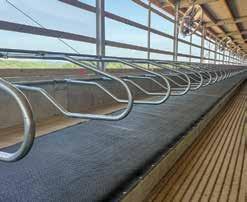

23 WWW.MILKPRODUCER.CA • FEBRUARY 2024 • Agri-Diamond Flooring Agri-Grid Sand Saver Huber Technik 4GS Mattress From installation to daily maintenance, our products are designed for labor efficiency, durability and comfort. Your time is valuable; your herd health is an investment. The Next Level of COW COMFORT info@agri-comfort.com • 1-905-945-3116 AGRI-COMFORT.COM ©2024 A Division of Agri-Plastics, Group of Companies
FROM WEST TO EAST: IDEAS ON FEED PRACTICES
By Essi Evans, E&E Technical Advisory Services & Brittany Wood, Canola Council of Canada
DAIRY FARMS ARE LARGER IN WESTERN CANADA THAN IN ONTARIO, and farms are getting bigger in both regions. Reviewing feeding practices on larger farms can provide insights into novel dairying concepts.
Farm sizes continue to become larger across Canada (Table 1), and Ontario is no exception. The trend is expected to continue as new technologies are applied. Noteworthy is the fact that, except for Newfoundland, average herd sizes are larger in the West, and have traditionally been larger than those in Ontario.
Researchers found
27.5% of all dairy farms in Canada milk between 20 and 49 cows, 77% milk fewer than 200 cows and only
11 Canadian farms operate with more than 1,000 cows.
1 Census of Agriculture, Statistics Canada
Agriculture and Agri-Food Canada researchers’2 analysis further point out that averages present only part of the picture. These researchers found 27.5 per cent of all dairy farms in Canada milk between 20 and 49 cows, 77 per cent milk fewer than 200 cows and only 11 Canadian farms operate with more than 1,000 cows. Furthermore, the percentage of farms with 250 or more cows is much greater in Western Canada, than in Eastern Canada (Table 2).
1 Agriculture and Agri-Food Canada
• FEBRUARY 2024 • WWW.MILKPRODUCER.CA 24 RESEARCH
Province 2006 2011 2016 2021 BC 113 126 150 163 AB 140 167 190 203 SK 132 203 233 227 MB 99 129 153 134 ON 68 79 92 101 QC 56 61 67 82 NB 70 83 91 116 NS 75 86 95 105 PE 60 69 82 88 NL 163 169 181 215
Table 1. Average number of milking cows/farm1
Table 2. Percentage of farms milking 250 or more cows1
Province Total number of cows (thousands) Percent of farms with 250 or more cows BC 80.4 14.5 AB 79.9 16.5 SK 27.7 18.3 MB 43.8 10.8 ON 323.0 4.1 QC 364.8 1.0 NB 18.8 3.5 NS 21.2 5.4 PE 13.8 2.5 NL 5.8 12.9
Feed continues to represent the largest single input cost3. One benefit of expanding herd size is the ability to take advantage of a wider range of commodity ingredients, meaning opportunities to reduce feed costs exist.
Researchers from the University of Guelph recently conducted a survey comparing feeding practices in the West, compared to Ontario. Most farms in Western Canada house cows in free stall barns, and many feed just one total mixed ration (TMR) to lactating cows that is mixed on-farm from a variety of commodities. The survey noted that larger Ontario farms also tended to feed TMR prepared from commodities stored onfarm. Many of the Ontario farms with fewer cows have tie-stall barns and these farms were likely to purchase dairy rations or protein supplements from feed mills.
Although larger farms in both the Western provinces and Ontario overlap in their use of major feed ingredients, dairy farms in the West tend to rely heavily on barley as the major grain, and canola meal as the primary source of protein. These ingredients are often absent in purchased feeds in Ontario, where the predominant grain and protein sources remain corn and soybean meal.
Barley grain has more protein and fibre than corn grain (Table 3). One major difference between the two is that the starch in barley is almost completely digested in the rumen, while rumen availability of starch in corn grain varies from 50-80 per cent. This means that less starch is required with barley to meet rumen needs, and the grain may not require as much processing for the starch to be digested by the rumen.
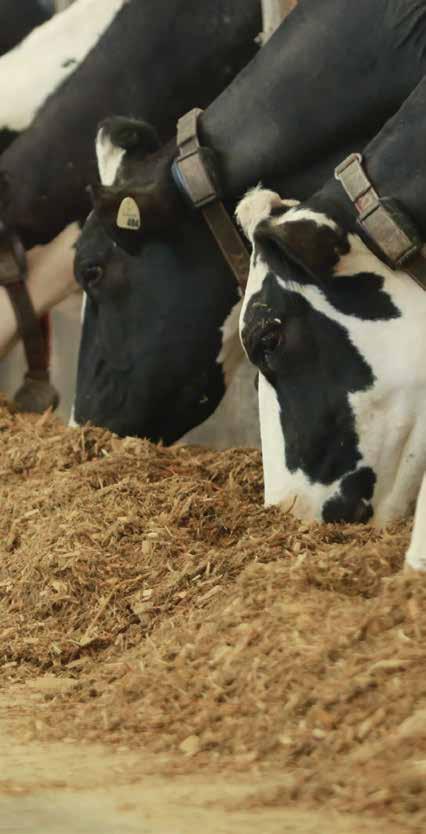
Table 4 provides a comparison between canola meal and soybean meal. As the table shows, canola meal has less protein and more fibre than soybean meal. However, canola meal provides more rumen undegraded (bypass) protein than soybean meal. The amounts of digested protein, that which is absorbed by the cow, are similar on a weight basis. The canola meal provides an opportunity to reduce ration protein while still providing high levels of rumen undegraded protein.

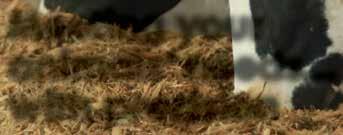
Meeting your animals’ needs... with precision

Trouw Nutrition is a pioneer in precision nutrition. For over 35 years, we have been balancing rations to amino acids with our NEWTON® formulation program. This means more accurate and cost-efficient diet formulations that meet the needs of your herd and are in line with your goals. No more, no less, just enough.
To take advantage of the power of NEWTON, talk to your Dairy Nutrition Advisor.

25 WWW.MILKPRODUCER.CA • FEBRUARY 2024 • trouwnutrition.ca
Nutrient, % of meal Barley Corn Crude protein 12.0 9.5 Neutral detergent fibre 19.0 10.0 Starch 55.0 72.0 Rumen digested starch, % 53.0 36.0 – 58.0
Table 3. Typical nutrient content of barley and corn grain (dry matter basis)



Nutrient, % of meal Canola meal Soybean meal
Crude protein
Neutral detergent fibre












42.0 49.9
29.0 14.9
Rumen undegraded protein, % 22.5 20.0
Digested protein, % 18.2 18.5
Table 4. Typical nutrient content of canola meal and soybean meal (dry matter basis)









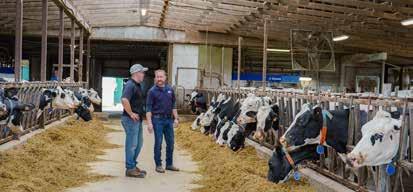

One major conclusion from the University of Guelph study is that Canadian dairy producers from both the West and Ontario build rations to focus on efficiency and milk production. Commodity ingredients are used to supply nutrients, and not just to lessen the cost of the ration overall. It is anticipated that Canada will have additional supplies of canola meal in the coming years due to canola processing expansion in the West. This change in ingredient availability may mean opportunities for more dairy farms in Eastern Canada to use canola meal.
References
1 Statistics Canada. Census of Agriculture Historical Data. https://www150. statcan.gc.ca/ (downloaded 2023-12-26)
2 VanderZaag, A., Bittman, S. and Wellisch, M., 2023. Farm size distribution in the Canadian livestock sector. Canadian Journal of Animal Science, 103(2), pp.218-222.
3 Canadian Dairy Commission. 2023. Cost of Production. https://www.cdc-ccl. ca/sites/default/files/2023-10/2023%20Cost%20of%20Production%20 FINAL.pdf
4 Gee, S.W., Kelton, D.F. and Carpenter, A.J., 2021. Survey of feeding practices on dairy farms in Ontario and western Canada. Canadian Journal of Animal Science, 101(4), pp.630-646.
OxfOrd Cattle COmpany
wants yOur Beef / dairy CrOss Calves

• Oxford Cattle Company is working with genetic companies to select sires for use in our guaranteed calf buy back program.
• We are now pleased to announce that we are interested in buying your holstein bull calves and can include them in your regular pick up. We will take calves that are over 92 lbs and 10 days old. The price will be negotiated on a weekly basis.
• Presently serving southwestern Ontario region and Ottawa region.
• For a Calf Pick Up Request text (519) 788-1399 by 1:00 pm Mondays
• FEBRUARY 2024 • WWW.MILKPRODUCER.CA 26 Our professional nutritionists formulate your herd’s rations starting with a full digestibility analysis of your forages. Our commitment to the Nutrition Direct approach ensures that we maximize the utilization of your forages, while incorporating safe, clean, cost effective vegetable protein commodities and performance maximizing premixes. Your herd’s potential. Nutrition that Maximizes Advanced Animal Nutrition for Improved Human Health /grandvalleyfortifiers Follow us on Talk to your GVF Dairy Specialist or Nutrition Consultant to learn more about the benefits of the Nutrition Direct approach. 1-877-625-4400 grandvalley.com Foerster-Technik North America Inc. | jan.ziemerink@foerster-technik.com BECAUSE EACH CALF COUNTS.
office@oxfordcattlecompany.com
PARTS AND LABOUR
An effective supply chain delivers training as well as state-of-the-art equipment
By Andrew Brooks
AS DONALD JOHNSTON, the 2024 winner of Dairy Farmers of Ontario’s Lifetime Achievement Award notes, one of the biggest changes he’s seen in dairy farming over the years has been the increasing complexity of the business (see article in this issue).
Not only is dairy farming much more of a business than it’s been in the past, with producers increasingly expected to play the role of CEO as they manage huge organizations and budgets: the dairy farming supply chain has also grown in complexity as the industry continues to leverage the latest scientific advances and technological innovations.
When asked how dairy farming has changed, Don Gordon, DFO board member and partner of his own dairy farm in Durham Region, Ontario, responds “It's not what our grandfathers did, that’s for sure. It's changed. Which is a good thing — everything's got to change. It's more efficient now, but you are more dependent on the machinery you've got.”
Gordon’s own farm is an example of how pervasive advanced technology has become. At 75 cows, the farm is relatively small, and yet Gordon uses robotic milking systems from Lely, which is one of the major providers of milking systems, along with Boumatic, GEA and DeLaval.
The complexity of these systems means producers depend on the availability of training and maintenance support from dealers or the equipment makers themselves. So when one of the big equipment manufacturers announces the opening of a new facility to provide training on its systems, dairy farmers pay close attention.
Don Gordon was on-hand when DeLaval Canada opened a new training facility in Peterborough, Ontario in December. The new 3,600 square foot facility, representing an investment of upwards of half a million dollars, will feature a technical lab housing two of DeLaval’s

“I think our industry needs it. I wouldn’t say there's a shortage of technicians, but I think there's always a need for them, and I think DeLaval's made a good step in setting something up to have training in this country.”
– Don Gordon
VMS milking robots, as well as a classroom, conference room and shared workspaces. At press time, rotary, parlour and stanchion displays were scheduled to be added.
“The new centre will have our entire conventional milking assortment, including our E series rotary wedge,” says Mark Futcher, director of DeLaval Canada. “It's not a full operational rotary because that would be of significant size, but it’s a rotary wedge, if you will – a cut-out from the full circle, a few stalls. And then all of our various peripherals and control systems for both conventional and automatic milking –farm management, behavior analysis, those sorts of things.”
Don Gordon says this kind of facility is needed in the dairy farming community. “I think our industry needs it. I wouldn’t say there's a shortage of technicians, but I think there's always a need for them, and I think DeLaval's made a good step in setting something up to have training in this country.”
The centre’s primary focus will be on training technicians and dealer staff, Futcher says. The centre offered its first training sessions last
27 WWW.MILKPRODUCER.CA • FEBRUARY 2024 •
RESEARCH
October, in advance of the official opening, and Futcher says these included direct training of the end customers, i.e. dairy farmers, though this training was focused on the company’s range of advisory services and support. These extend to biosensorbased animal behaviour analysis and farm management software, and includes an artificial intelligence platform that provides farmers with information about a cow’s reproduction status, well-being and location.
“Today, in many cases, dairy producers are leveraging much more technology than a milking system alone, by integrating several technologies such as system monitoring, animal behavior analysis, milk component analysis, and others that assist with overall farm management, routines, and protocols,” Futcher says. “Every farm manages differently, so alignment with the owners and operators of a farm—with the milking system and other solutions that fit the management style and capabilities of the farm—helps ensure success with the equipment they’ve chosen.”
For Don Gordon, which equipment brand a farmer chooses is less important than ensuring that equipment is well maintained and serviced.
“It's the maintenance on it, the upkeep, the repairs to make sure it's working properly. You've got to have them working the way
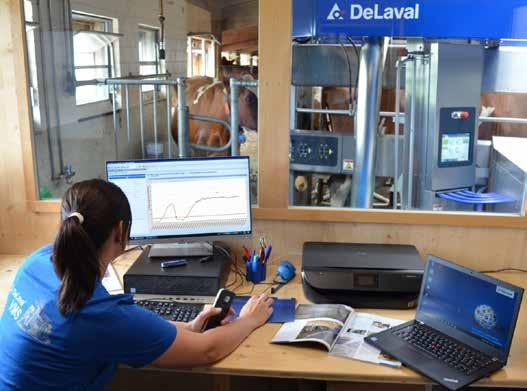
The centre’s primary focus will be on training technicians and dealer staff, Futcher says. The centre offered its first training sessions last October, in advance of the official opening, and Futcher says these included direct training of the end customers.
they should work, which is, to me, why these technicians are important. As a producer, you assume the training will be there. The biggest thing when you're looking at a system is the dealer relationship, how much support you're going to get.”
“A ‘milker’ doesn’t directly link to increased
milk production,” Futcher says, “but providing dairy farm owners or operators with a greater level of technology and reliable information, at the right time and place, enables farm management to make accurate decisions in a proactive manner, which should have a positive impact on overall productivity.”


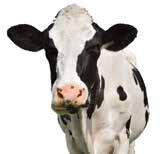

• FEBRUARY 2024 • WWW.MILKPRODUCER.CA 28 by Call 306-543-4777 Email ot@otfarms.ca Reducing methane / carbon neutral Land-based ingredient (sustainable) WE’RE AT CDN DAIRY EXPO HALL 2


MANAGING FOR BETTER CALF IMMUNITY
Examining the strong impact the first months of life can have on lifetime performance
By Pedro Nogueira
NUTRITION AND MANAGEMENT OF YOUNG CALVES continues to be a hot topic in the industry, especially with research demonstrating the strong impact the first months of life can have on lifetime performance. Two main areas of research are currently very active; one that is attracting a good deal of attention relates to how the rumen is colonized by micro-organisms. It is known that at birth, young ruminants possess no anaerobic microbial population in the rumen. Microbes have to colonize the rumen for the physiological development of the rumen itself and for the animal’s ability to convert food into products that it can use for maintenance and production. What is not well understood is what management factors impact this.
Microbes have to colonize the rumen for the physiological development of the rumen itself and for the animal’s ability to convert food into products that it can use for maintenance and production.
Another area that has received less attention until now is the development of the lower gut – the abomasum, cecum and intestines. Dr. Mike Steele from the University of Guelph indicates areas that require more focus and research include early-life intestinal gut barrier function and growth. He’s also interested in how the weaning transition affects the function of the rumen and intestines. The latest research suggests ruminal and intestinal barrier function is compromised during the pre-weaning and weaning phase. Understanding how diet and microbiota can affect growth and barrier function of the intestinal tract may facilitate the development of specific management regimens that could influence gut function. As
• FEBRUARY 2024 • WWW.MILKPRODUCER.CA 30 CALF CARE
Dr. Steele says, “the gastrointestinal tract (GIT) plays a significant role in animal energetics since it utilizes 20 per cent of the oxygen in the whole animal and accounts for 30 per cent of metabolic and protein synthesis activities of the cow. Thus, although adaptations to the gut are local, they can influence the entire dairy cow or calf system.”
We can think of the digestive tract as a hose, starting at the mouth and ending at the anus. The contents inside that hose (the gastrointestinal lumen) are separated from the lymphatic and portal circulation by two distinct epithelia or membranes - the one that lines the reticulo-rumen and the omasum, and the one that lines the abomasum, intestines and cecum. Dr. Steele says the gastrointestinal epithelium’s (GE) primary roles are to protect the host from the mixture of micro-organisms, toxins and chemicals in the lumen, and prevent these compounds from moving into the lymphatic or portal circulation. These membranes act as a physical, chemical and biological barrier that continuously senses the composition of the gut’s interior to protect against threats to its integrity and improve nutrient absorption and delivery of nutrients to other body tissues.
Dr. Chris Chase, a professor from South Dakota University, says researchers have shown the epithelial cells of the gut and respiratory tract act as an immune organ. “This means the cells are not just there to absorb and secrete, but also pick up signals—particularly signals from the microbiome,” he says. “The microbiome is a collection of micro-organisms in the intestinal tract of animals and we know these micro-organisms are essential to immune development.”
PRE-WEANING
Pre-weaned calves are the most at-risk population of cattle on the farm for gastrointestinal epithelium malfunction, with digestive disorders and diseases, primarily from scours. A recent survey in Canada and the United States showed 23 per cent of dairy calves are treated for diarrhea with antibiotics during the pre-weaning phase. This is particularly important since health affects longevity. It is known calves treated with antibiotics during the pre-weaning period produce less milk over their lifetime (Soberon et al., 2012). This means it’s important to establish a stable microbial population. This allows the gastrointestinal epithelium to develop,
“The gastrointestinal tract (GIT) plays a significant role in animal energetics since it utilizes 20 per cent of the oxygen in the whole animal and accounts for 30 per cent of metabolic and protein synthesis activities of the cow. Thus, although adaptations to the gut are local, they can influence the entire dairy cow or calf system.”
– Dr. Steele, University of Guelph

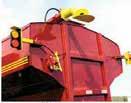






31 WWW.MILKPRODUCER.CA • FEBRUARY 2024 • Michael Stabling Developments mpyfferoen@gmail.com www.sgate.ca 519-794-3933 MICHAEL’S STABLING DEVELOPMENTS INC. Manufacturer of all types of milking parlor frames • Parabone • Herringbone • Parallel • Rapid Exit • Tandem style • Also custom orders • Self lock head gates • Pro free stalls • Slant stalls and gates • Calf pens • Tie stalls • Tip tanks High performance, low maintenance stabling solutions that will benefit you and your livestock each and every day.
6918 Middlebrook Rd., RR1 West Montrose, ON N0B 2V0 519-669-5772 JEMBROOK WELDING INC. • General Welding • Tank Manufacturing • Repairs
improve prevention of gastrointestinal infections and overall gut barrier function. This will result in improved efficiency, food safety and animal welfare.
During pre-weaning, the closure of the intestinal permeability to the immunoglobulins of colostrum is one of the most important changes in terms of gut function. This is why it is so important to feed colostrum quickly after calving. Although it is known this occurs, the precise mechanisms that control this closure are not known.
Dr. Steele indicates colostrum and milk have often been described as the complete prebiotic since they contain one of the largest collections of bioactive proteins, carbohydrates and fatty acids. In particular, colostrum has a large number of growth factors, all of which directly affect gut growth signaling pathways. Another example of the importance of colostrum to gut development is research focusing on the effect of colostrum feeding duration, which promotes growth responses in different small intestine structures. It is thought the bioactive components in colostrum mainly establish a balanced microbial population and gut growth in the first days or weeks of life, but Dr. Steele says they are not yet clearly described.
WEANING
Weaning brings with it two major changes: feed digestion moves from liquid feed, occurring primarily in the abomasum and small intestine, to solid feed, primarily fermented in the rumen. Weaning results in a change in digestion and absorption sites, and the type
is needed to understand how these changes influence the lower gut, particularly the function of the gastrointestinal barrier, which has multiple functions and is very important because it prevents the passage of unwanted substances to the blood. This can trigger an inflammatory response and cause reduced growth and performance. In some studies, an increase in inflammatory markers during weaning suggested calves may also suffer from temporary hindgut acidosis, as indicated by elevated levels of starch in the manure during weaning.
Dr. Steele indicates finding optimal weaning strategies that stimulate gastrointestinal epithelium development becomes extremely important, especially with the current recommendations of feeding higher levels of milk. Dry feed intake before weaning is critical to avoid growth loss and disease after weaning. He says the industry needs to develop practical strategies that allow for a balance between accelerated weight gain but also an accelerated development of all digestive organs and membranes. He concludes by saying “greater investigation of the lower gut microbiological, structural and functional changes and how these changes contribute to weaning stress is a logical next step in research.”
On a practical level, here are some of the most important steps around weaning to promote solid feed intake:
1. Provide clean, fresh water at all times;
2. Provide fresh calf starter;
3. Use a step-down approach in terms of the amount of milk being offered;
4. Ensure ample and easy access to the feed bunk;
5. Maintain high levels of comfort.
These may help reduce disease risk and growth setbacks on this naturally stressful phase of a calf’s life.
Pedro Nogueira, Dairy Technical Services Support, Trouw Nutrition Canada.



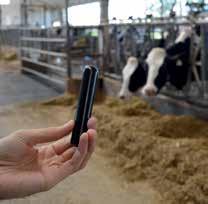
• FEBRUARY 2024 32
Start your 6-month free trial!* Lifetime monitoring of your animals, from calf to cow. BOLUS SYSTEM cattlescan.ca PRODUCER +1 (800) 758-5294 info@cattlescan.ca • Early detection of illness • Advanced reproduction management • Monitoring temperature, rumination, activity and water intake 24/7 Mention this promo code

MILK TRANSPORTERS ARE AN ESSENTIAL LINK IN THE SUPPLY CHAIN
By Theresa Rogers and Robert Price
YOU MAY HAVE PASSED KEN PENNINGTON ON THE 401 WITHOUT NOTICING. He is a certified Bulk Tank Milk Grader (BTMG) for James Dale Milk Transport. As a BTMG, he grades milk to ensure the product Ontarians drink meet the dairy industry’s high standards for quality and drives the tank trucks that carry milk from the dairy farm to the processing plants.
It’s a job that takes good driving skills and a good nose.
GETTING INTO THE BUSINESS
The idea of driving a milk truck entered Pennington’s mind at an early age. Raised on a farm, he grew up seeing milk trucks going down the road and meeting the always polite drivers.
“I always thought that would be kind of cool,” he says.
After hauling water tankers, he earned his BTMG certificate from Dairy
Farmers of Ontario and in 2011 started hauling milk. The job came with better pay, a better benefits package, a uniform, and a commitment to cleanliness Pennington appreciates.
To earn a BTMG certificate, a person must take a comprehensive training course, pass an examination, and undergo a practical assessment that focuses on milk quality standards, sampling techniques, and equipment use. The process can take several weeks or months and ensures candidates are adept at maintaining dairy industry standards.
Today, Pennington drives a route that takes him from his home near Goderich to Toronto and back. He compares driving favourably to the years when he worked in a factory. On nice days he can put the windows down and drive. “You get to see the daylight,” he says. The hardest part of his job, he says, is that traffic around the Greater Toronto Area doesn’t always flow as easily as the milk he pumps in and
33 WWW.MILKPRODUCER.CA • FEBRUARY 2024 • SUPPLY CHAIN

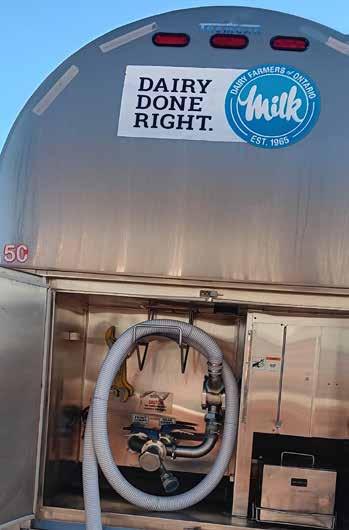
After smelling the milk in the tank, he does a sight test and measures the milk with a dipstick to see how many litres of milk is in the tank. He then agitates the milk for two minutes and takes a sample that is sent to Guelph for testing. out of his truck.
“There’s a big accident every day,” he says. If constant construction on the major arteries isn’t slowing traffic, inconsiderate drivers who pump the brakes and drive wildly add to the stress of driving a tractor trailer.
“From other drivers, you don’t get any respect. You’re getting cut off. People honk their horns at you. I concentrate on what I’m doing and try not to get too stressed out.”
The other problem facing truckers like Pennington is the weather. And that can be as unpredictable as other drivers.
One winter, Pennington came off the highway and started down a sideroad. “It was a sheet of ice,” he recounts. He slid out and had to call his next pick up to help him get back on the road. The producer arrived with sawdust but the wind carried it all away. They managed to snag a truck with a sander on the back, and with a carpet of sand under tire, Pennington got the truck up the sideroad so he could make his next pick up.
SNIFF TEST
Milk graders need to have noses as refined as their driving skills.
To grade milk, drivers need to earn a certificate. This training teaches them how to distinguish good milk from bad.
Testing involves shutting off the cooler and checking the temperature. Next, Pennington opens the tank and takes a deep breath. Pennington says it’s important to conduct the sniff test when he opens the tank. “You need to get the first aromas,” he explains.
• FEBRUARY 2024 • WWW.MILKPRODUCER.CA 34

As a BTMG, Ken grades milk to ensure the product Ontarians drink meet the dairy industry’s high standards for quality and drives the tank trucks that carry milk from the dairy farm to the processing plants.
After smelling the milk in the tank, he does a sight test and measures the milk with a dipstick to see how many litres of milk is in the tank. He then agitates the milk for two minutes and takes a sample that is sent to Guelph for testing. If the milk is good, it goes in the tank, then to the processing plant and eventually into the mouths of consumers.





877-966-3546
Pennington enjoys his work, stands behind the industry’s commitment to cleanliness, and finds the labour long but worth his time. All this puts a shine on his life.
“I like the outdoors,” he says. When he’s driving his truck in the sunshine with the radio playing, he feels free.
“I get to be my own boss.”
35 WWW.MILKPRODUCER.CA • FEBRUARY 2024 • Providing Permanent Traction forfarmers thatlastsdecades! 877-966-3546 www.agritraction.com AGRI-TRAC Milled our dair y barn floors in of 2000.22 Years later we just had AGRI-TRAC backto do them again. It lasted 22 Years! We chose AGRI-TRAC bothtimesinstead of grooving because it works and lasts. We have experience, grooving does NOT work! Thank you AGRI-TRAC.
Vriens Friendly Farms Arthur, ON like how the floor is easy James Wa Over 25 Years Providing Permanent Traction for farmers that lasts decades! www.agritraction.com 1-877-966-3546 • Reduce hoof and leg injuries • Reduce cull rates AGRI-TRAC milled our dairy barn floors in August of 2000. 22 years later we just had AGRI-TRAC back to do them again. It lasted 22 Years! We chose AGRI-TRAC both times instead of grooving because it works and lasts. Thank you AGRI-TRAC. Mario Vriens, Friendly Farms, Arthur, ON AGRI-TRAC gives the cows the traction they need without being too aggressive on their feet. We also like how the floor is easy to scrape and clean. James Walker, Walkerbrae Farms Guelph, ON Providing Permanent forfarmers thatlastsdecades!
Mario
www.agritrac AGRI-TRAC Milled our dair y barn floors in August of 2000.22 Years later we just had AGRI-TRAC backto do them again. It lasted 22 Years! We chose AGRI-TRAC bothtimesinstead of grooving because it works and lasts. We have experience, grooving does NOT work! Thank you AGRI-TRAC. Mario Vriens Friendly Farms Arthur, ON Jeni Mobile Wash www.jenimobile.com MIKE RYAN Fergus, Ontario 1-800-361-3637 Monkton, Ontario 1-877-325-8843 Since 1986 We specialize in BARN WASHING
HO W GENERATIVE AI CAN PLAY A ROLE ON YOUR FARM
By Rebecca Hannam
GENERATIVE AI is a type of artificial intelligence that creates text, images and other types of media in response to prompts. By learning existing data and identifying patterns, large language models make it easy for users to quickly generate new and original content.
One of the most popular generative AI tools, ChatGPT, went viral on social media after an early demo was released publicly in late 2022. More than 100 million users are now putting the chatbot to work to answer questions and help complete a variety of tasks.
FARM BUSINESS USES
Morgan Wadsworth, innovation specialist at FCC, says ChatGPT has taken the world by storm and has essentially become an assistant to everyone.
Generative AI models can be used to learn about virtually any topic, including farm business planning and other areas where farmers may be seeking knowledge. From crops and pests to commodity market cycles, financial management and more, these tools can be viewed as built-in learning services.
ChatGPT is also changing the way marketing content is generated. It’s become known for boosting creativity and reducing writing time, which could be a game-changer for agribusinesses that have websites, post blogs or use social media.
GENERATIVE AI IS HELPFUL NOW, BUT IT’S ONLY GOING TO GET BETTER
“Where this technology is headed is quite powerful,” Wadsworth says. “Farm software companies are looking at ways to factor AI into their offerings so farmers can make critical decisions using their operational data. It’s going to open up access to information and insights in a different way, where you don’t have to rely on waiting for a human advisor.”
HOW TO GET STARTED
Wadsworth encourages farmers to try ChatGPT or other models but cautions not to approach them like a Google search.
The more information and context provided in the prompt, the better the output data will be. A recommended rule for optimal results is to write the prompt as if you are talking to an expert to seek advice.
Wadsworth also advises farmers to err on the side of caution and make sure to factcheck generative AI responses. Although platforms appear very confident in their answers, some could generate inaccurate information because they are either trained on false information or are not up-to-date with current events.
“It’s a great time to ease into generative AI and get familiar with it,” he says. “More AI is coming and it’s going to be very accessible to every farmer very shortly.”
Rebecca Hannam writes for Farm Credit Canada, Canada’s leading agriculture and food lender. FCC provides a complement of expertise and services designed to support the complex and evolving needs of food businesses.
One of the most popular generative AI tools, ChatGPT, went viral on social media after an early demo was released publicly in late 2022.

RECOMMENDATIONS FOR DEVELOPING AN ONTARIO PATH FORWARD FOR DEADSTOCK
By Lilian Schaer for Livestock Research Innovation Corporation
A NEW REPORT FOR LIVESTOCK RESEARCH INNOVATION
CORPORATION (LRIC) has set forward a list of recommendations for managing on-farm livestock mortalities in Ontario.
Topping the list is the establishment of a coordinating body to oversee deadstock management in the province, coupled with continued investment by both industry and government to support that organization’s activities.
The other recommendations suggest working with waste management companies on potential solutions, reviewing current regulations to ensure they are scientifically sound, and streamlining regulations related to deadstock across multiple government agencies.
Ontario is a large and diverse province, meaning there is no single or simple solution for the industry that will work for all livestock commodities in all geographies. Deadstock, however, is a global issue and Ontario is hardly alone in grappling with how to best manage it from a One Health perspective in a way that protects human, animal and environmental health.
“The livestock sector is a key pillar of Ontario’s economy, environment and food security, and solutions need to support livestock producers regardless of species or location,” says LRIC CEO Mike McMorris. “Deadstock has been a challenge for our industry for decades and we are hopeful that this report, coupled with the interest of stakeholders to work together, will help us achieve a longer-term solution.”
The project was launched in 2022 by LRIC with funding provided by the Ontario Ministry of Agriculture, Food and Rural Affairs (OMAFRA) in response to a request from Dairy Farmers of Ontario, Beef Farmers of Ontario, Ontario Sheep Farmers, Veal Farmers of Ontario, and the Ontario Federation of Agriculture for help in finding practical and sustainable solutions to the livestock mortality issue.
Study lead Jennifer MacTavish consulted with approximately 70 individuals and organizations over the course of the project and completed an international scan as part of the research.
Both Ontario farmers and the provincial government prefer to use rendering wherever possible, but escalating costs have made on-farm pick-up uneconomical across a large part of Ontario, and steadily
Ontario is a large and diverse province, meaning there is no single or simple solution for the industry that will work for all livestock commodities in all geographies.
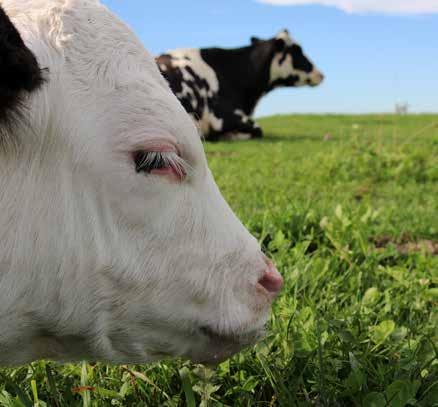
increasing regulatory requirements are making it harder for rendering companies to operate profitably.
Regulations impacting handling and disposal of on-farm mortalities lie within five different provincial acts and 12 different organizations touch deadstock in some way, resulting in no real coordinated approach to the issue.
“The recommendations in the report are focused on moving the industry towards a more coordinated approach to managing on-
37 WWW.MILKPRODUCER.CA • FEBRUARY 2024 • RESEARCH
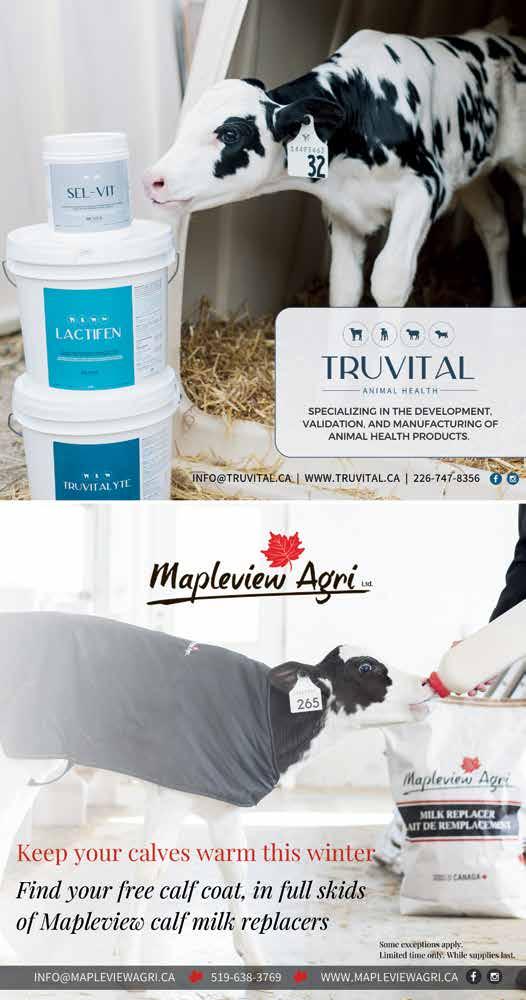
farm mortalities. We need to build adaptability to geographical and species differences with a focus on One Health,” says McMorris.
COORDINATING BODY
The report recommends the establishment of a coordinating body to ensure ongoing, full-sector development and implementation of solutions. To avoid adding another layer of bureaucracy, it is recommended to approach an existing organization or interested group of individuals, companies and organizations to immediately begin work on the issue. Initial funding could be provided by industry and government.
The role of this new coordinating body would include tasks like prioritizing and funding research needs, providing financial offsets for farmers in some regions and investing in key stakeholder infrastructure where needed, offering input on regulatory changes, supporting waste management companies in navigating the regulatory landscape, developing business cases for disposal options, evaluating the feasibility of different organizational models to ensure a sustainable approach to deadstock management services and more.
It could also coordinate pre-competitive conversations with stakeholders on how to manage surge capacity, develop a matrix that considers the impacts of rendering capacity issues on the sector, and build contingency plans for situations where rendering capacity is limited.
“Most importantly, however, this organization would lead the building of relationships across the sector so regulation and problem solving can be approached in a collaborative way,” notes McMorris, adding that there are several organizations representing livestock farmers with successful histories of working cooperatively with government, including Ontario Livestock and Poultry Council, LRIC and CanLead.
• FEBRUARY 2024 • WWW.MILKPRODUCER.CA 38
Underpinning sustainable deadstock management is continued investment that supports farmers with disposal needs, particularly ensuring ongoing, uninterrupted collection.
CONTINUED INVESTMENT
Underpinning sustainable deadstock management is continued investment that supports farmers with disposal needs, particularly ensuring ongoing, uninterrupted collection. It also includes activities like on-farm euthanasia training, building a business case for the benefits of deadstock to a circular economy, and assisting farmers and other stakeholders with planning and critical infrastructure costs.
WORK WITH WASTE MANAGEMENT COMPANIES
The coordinating organization could help waste management companies work more collaboratively with government and the livestock industry to build business cases for making use of deadstock as an input instead of treating them like a waste stream. Waste management companies also need help navigating the regulatory landscape around deadstock, particularly when looking at growth opportunities.
REVIEW EXISTING REGULATIONS
The report recommends a review of existing regulations to ensure they are scientifically sound, streamlined across regulatory agencies and capable of enabling the industry to take advantage of the economic opportunities presented by deadstock in relation to a circular economy.
NEXT STEPS
An initial meeting of 30 deadstock stakeholders in June 2023 that included producer groups, government, renderers, waste disposal companies and others resulted in a request to form a working group to tackle the issue.
It was also agreed that there is a need for greater producer education and outreach around deadstock management, including the economics and risks of on-farm disposal versus rendering.
This working group has been meeting regularly to review and discuss a ‘menu’ of potential follow up actions to OMAFRA. There is broad agreement that new deadstock funding opportunities through the Ontario Ministry of Agriculture, Food and Rural Affairs and the Ontario Agri-Food Innovation Alliance could be used to potentially determine centralized collection sites, for example.



39 WWW.MILKPRODUCER.CA • FEBRUARY 2024 • SCHOOL OF DE DELL Hybrid: DL 3905 – 2850 CHU, 95 RM SUBJECT MARK Topping plot at Courtland and Avon. Top 3 hybrids across all tested locations. Outperformed ALL competition at Ilderton, Avon and Brunner. Excellent agronomics. Excellent performance in OCC & RGCQ provincial trials! COMMENTS DL 3905 proved itself this year plot after plot. High yielding new genetics with solid agronomics. NEXT STEPS You should try DL 3905 in 2024! REPORT CARD A+ A+ A+ A+ A+ SCHOOL OF DE DELL Hybrid: DL 5021 – 3000 CHU, 100 RM SUBJECT MARK Topping plot at Thamesford and Ilderton. Outperformed ALL competition at Thamesford, Ilderton, Avon and Brunner. In the top 3 De Dell hybrids across all tested locations. Excellent agronomics. COMMENTS DL 5021 proved itself this year plot after plot. Combining high yield and solid agronomics, DL 5021 was a top performer! NEXT STEPS Plant DL 5021 on yur farm in 2024! REPORT CARD A+ A+ A+ A+ De Dell Seeds • 7095 Century Drive • Melbourne, ON • N0L 1T0 P: 519-264-CORN (2676) • F: 519-264-2672 • 1-833-436-CORN (2676) info@dedellseeds.com • www.dedellseeds.com De Dell Seeds The Leaders in Non-GMO Corn HOMEWORK! WE’VE DONE OUR 4 LOCATION SUMMARY Average DL3905 DL5021 P9946AML A6757G8 RIB A6015 A6016RR DL3146 Moisture (%) 27.3 29.9 29.4 28.4 26.0 26.7 25.8 Yield (bu/ac) 243 251 221 206 186 208 207 Test Weight (lbs/bu) 52.2 53.1 52.3 51.5 51.6 51.8 53.3 1 (519) 527-2470 | sunnorth.com AIR MOVEMENT | CURTAINS | PANELS | EXHAUST VENTILATION & COOLING SOLUTIONS
YOUNG GERMAN DAIRY FARMER SECURES INCOME FROM MILK, BEEF AND MANURE
By Chris McCullough


WITH INPUT COSTS ON DAIRY FARMS SPIRALLING a young farmer in Germany is adding more value to his farm outputs and even by-products to boost profit margins. Rainer Boger, 31, runs his farm to generate income from not only the milk produced by the cows, but also from the manure and the Holstein bull calves.
Milk prices in Germany have fallen over the past few months but to help counteract this, Rainer also fattens the bull calves to sell for beef and converts the manure to sell as energy.
Rainer farms 300 hectares near the town of Ruthen in the district of Soest, in Germany’s North Rhine-Westphalia region. He is taking over the running of the farm from his father Reinhold, 66, and investing in just enough technology to make this a less labour intensive unit.
The Boger family run 250 cows, 80 per cent of which are Holstein and the remainder are Ayrshire. They are kept indoors 24 hours per day all year round and are milked using six Lely A4 robotic milking units, the first of which was installed ten years ago. The herd has been expanding quite rapidly over the years since it only comprised of 40 cows 12 years ago.
Growing most of the cereals they need to feed the cows, replacements and bulls, saves the Bogers a lot of money on concentrates and increases the sustainability of the farm.
“We grow cereals on around 150 hectares, mostly triticale, wheat and barley,” said Rainer. “Other ingredients are purchased to include in the TMR for the cows.
“Normally we take up to five cuts of
• FEBRUARY 2024 • WWW.MILKPRODUCER.CA 40 WORLD DAIRY
Rainer farms 300 hectares near the town of Ruthen in the district of Soest, in Germany’s North Rhine-Westphalia region.
silage and one cut of maize on the other 150 hectares to further boost the home grown feed supplies for the cows. This works well to utilise our own manure from the cows, but we also run two biogas plants here selling energy to the grid.”
Rainer’s cows average three visits per day to the robotic milking units and produce an average 34 litres per day in the summer time and up to 37 litres per cow per day in the winter time. His overall production average sits at 11,500 litres per cow at 3.4 per cent protein and 4.0 per cent butterfat base levels. The milk is sold to the Frischli processor for 38 euro cents per litre (CAN$0.56), which Rainer is not happy with.
“We need around 40 euro cents per litre to break even,” Rainer said. “During 2023 we received 60 euro cents (CAN$0.88) per litre. Prices were quite good at 54 euro cents (CAN$0.79) up until a few months ago but now there is little money to be made as a
Farm and Family
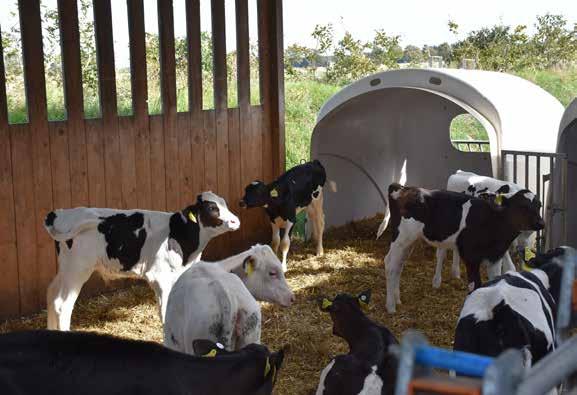
profit, if any.
“We have three workers here at the farm mostly looking after the livestock. The majority of the cows are AI’d using sexed semen for the top 80 percent of the cows, and the remainder are put to the bulls.”
The cows are fed once per day with a TMR including 23kgs of corn, 25kgs of grass, 0.5kgs of straw, 8kgs of cereals, and 600g of a mineral. Each cow eats 55kgs TMR fresh weight per day and concentrates in the

robotic milker.
“Every cows gets one kilo of concentrates and the best producing cows will receive a top up to three kilos total per day,” he said. Rainer runs all the bull calves born on the farm as bull beef to around 19 to 20 months old, when they are ready for slaughter.
Rainer said: “The aim is to add value to the bull calf while at the same time producing a top quality beef animal that consumers want. “The bulls are killed at around 20 months old
Does your succession plan work for both?

Don’t risk your legacy, take our simple self-assessment and find out where you stand. Scan here to start

41 WWW.MILKPRODUCER.CA • FEBRUARY 2024 •
MNP.ca


www.vetoquinol.ca BECAUSE THEIR WELL-BEING MATTERS KETOPROFEN INJECTION MFR. CONSULT YOUR VETERINARIAN Farmafen™ clubveto quinol.ca PRODUCT ELIGIBLE FOR POINTS
DFC IN ACTION


Sustainable practices by producers and processors, trade policies, and market outlooks top issues for 2024 policy
conference
Dairy farmers on the Hill
On February 6, dairy farmers from across Canada gathered in Ottawa to meet with Ministers, Members of Parliament, Senators, and government officials to discuss critical issues facing the Canadian dairy sector. Despite a significant snowstorm shutting down flights from parts of the Maritimes, dairy farmers met with more than 100 parliamentarians and officials and spoke about the importance of ensuring that the Canadian Food Inspection Agency (CFIA) protects and enforces Canada’s dairy terminology, asked for the review and modernization of Business Risk Management programs, and highlighted the importance that Canada pursues the elimination of the surcharge on dairy products during the upcoming review of the Canada-United StatesMexico Agreement (CUSMA).
As per usual, DFC ended its lobby day with a well-attended reception for Parliamentarians. Thank you to the dairy farmers who took time away from their farms to educate politicians about on-farm challenges farmers face from coast to coast.
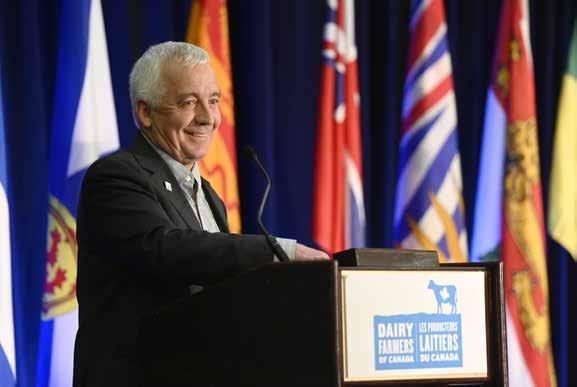
Highlights from the 2024 Annual Policy Conference
Building a robust and modern Canadian dairy industry for the future was the theme of Dairy Farmers of Canada (DFC)’s 2024 Annual Dairy Policy Conference in Ottawa. The two-day event featured a lineup of insightful speakers and engaged delegates on topics ranging from sustainable farming practices and the need for enhanced data collection, to domestic and global market outlooks and trade policies.
Dairy Farmers of Canada President David Wiens kicked off the conference with a rallying call to address the pressing issues of the day - including the changing environment and high production costs - while also looking ahead to build and shape the future of the dairy industry.
Wiens stressed that the focus must be on market growth and ensuring current and future trade agreements don’t become “one-way streets into our markets.” The upcoming presidential election in the United States will be important for Canada’s dairy sector: “We must be ready to defend our industry, and with your active engagement, Dairy Farmers of Canada will continue this work,” said Wiens.
Oth e r key speakers of the conference inc luded the Honourable Mary Ng , P. C ., M . P . , m inister of export p romotion, international trade and economic development, who took part in a fireside chat with DFC CEO Jacques Lefebvre where she outlined Canada’s trade o p portunities and ch allenges. She said a “ Team Canad a” approach will be taken, a nd wh en speaking a bout the upcomin g review for dairy i n 2025 in the C anada- United Stat e s-Mexico Agreem e nt (CUSMA), Ng d e scribed Canada’s supply management system as “foundational” to our food security. On suspended trade talks with the United Kingdom, she said: “We’re not giving up access to cheese.” This supports DFC's position that making up market access lost to the EU after Brexit is not the Canadian government's problem to solve.
Stefanie Beck, deputy minister, Agriculture and Agri-Food Canada, weighed in on farmgate milk pricing, supply management, sustainability, and the recent Methane Challenge. She said it was wise to postpone an increase in the farmgate price of milk to May 2024 instead of February, as per usual. She also said the government is fully committed to our system, saying that “supply management is here to stay,” echoing Minister Ng’s sentiment.
Maxime Collette, DFC’s senior analyst of market intelligence, looked at how Canada’s rising population will drive an increase in food demand: “So when we have more people, that means we have to feed more people, and that has a direct impact on dairy.” At the same time, Canadian dairy farms continue to decline, with 9,443 in 2023, down three per cent from the previous year. He noted that in 2023, while the cost of all food rose by 7.5 per cent year-over-year, dairy products rose slightly less at 6.5 per cent.
• FEBRUARY 2024 • WWW.MILKPRODUCER.CA 44
DFC President David Wiens

Christophe Lafougère, CEO of GIRA, a consulting and research company that specializes in world agri-food issues, said Canada is well-positioned to take advantage of a time of slowing global milk production, which is expected to only grow marginally during the next five years while consumption of dairy products continues to expand. “At the world level, that starts to raise some issues for the future: where will the milk come from?” Lafougère pondered.
Rory Christie, partner with Dourie Farming Company Ltd. and vice chair of the Scottish Agricultural Organisation Society, offered an overview of Scotland’s experience in sustainable economic production. He spoke about the challenge of succession at a time when the average Scottish dairy farmer is 59 years old. He also stressed the need for dairy farmers to show they are taking action to address climate change by tracking data. “There’s nothing to fear with reducing your carbon footprint,” Christie said.
Hélène Morissette, vice-president of corporate responsibility for Saputo Inc., said that as a dairy processor, Saputo is getting increased demands from customers, including retailers and restaurants, about greenhouse gas emissions data. When she gets those requests, she needs to turn to suppliers for the information, which has a domino effect that then goes towards the milk supply.
Cristine Laforest, general manager and CEO of Groupe Bel Canada, recounted the history of the company and its successful brands such as the Laughing Cow (La vache qui rit) and Babybel, and discussed dairy sector responses on achieving sustainable growth, fighting climate change, providing healthier food and tackling food waste, among other challenges. Laforest also shared how adding DFC’s Blue Cow label has increased Groupe Bel Canada’s sales by 29 per cent.
Daniel Foy, co-founder and CEO of AgriGates, a U.S.-based agri-tech company focused on the integration and aggregation of farm-level data, told delegates about the value of data and how it is important for the use of artificial intelligence (A.I.) technology. Foy stressed that farmers own the data that is produced on their farm before and after algorithmic processing. He sat down with the hosts of the Canadian Podcow, where he laid out the implications of A.I. in a simple, clear conversation.
Overall, the conference was foundational not only to DFC’s advocacy work but to furthering key discussions and actions for the future of the dairy sector.
DFC thanks everyone who attended this year’s APC.

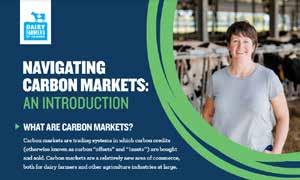
Navigating carbon markets: a new toolkit for farmers
At DFC, we are all committed to sustainability. Dairy farmers like you have been working hard towards our sector’s goal to reach net-zero greenhouse gas emissions by 2050. You’re implementing best management practices for the environment while continuing to produce milk that meets some of the highest standards in the world. But did you know that while these practices help reduce, capture or lower carbon emissions, they can also create carbon credits that could become a new source of revenue for your farm?
That’s where carbon markets come in.
In this new handout, DFC introduces farmers to carbon markets, providing a high-level overview of what they entail and how farmers can participate in them. We are also developing a toolkit of resources that will offer more detailed information on things like how to sell carbon credits, how to understand and handle risks, and a list of frequently asked questions that farmers may have.
If you’re interested in assessing how you can participate in a carbon market and if its a good fit for your farm, visit DFC’s Farmer Resources Hub today: https://dairyfarmersofcanada.ca/en/ farmer-resources/tools/navigating-carbonmarkets
The Honorable Mary Ng sat down for a fireside chat with DFC CEO Jacques Lefebvre
As every producer and member of the dairy supply chain knows, a lot goes into producing a great glass of milk like the one on this October 1988 cover.
It also takes a lot of people to help produce the same glass of milk, including your vet, feed specialist, truck drivers, lab specialists, equipment suppliers, on-farm workers and more.
Many more people work on the processing side. In an article a couple of months earlier, Brian Kipping, then Director of Government and Industry Affairs for Ault Foods Ltd., wrote the processor’s primary responsibility is to fully understand consumer needs and develop products to sustain and increase dairy’s share of the consumer’s food purchase.
“Dairy producers should take great pride in their efforts,” of assuring a stable supply of high-quality milk, he wrote. With these pieces in place and a partnership approach to managing the industry, it will flourish.
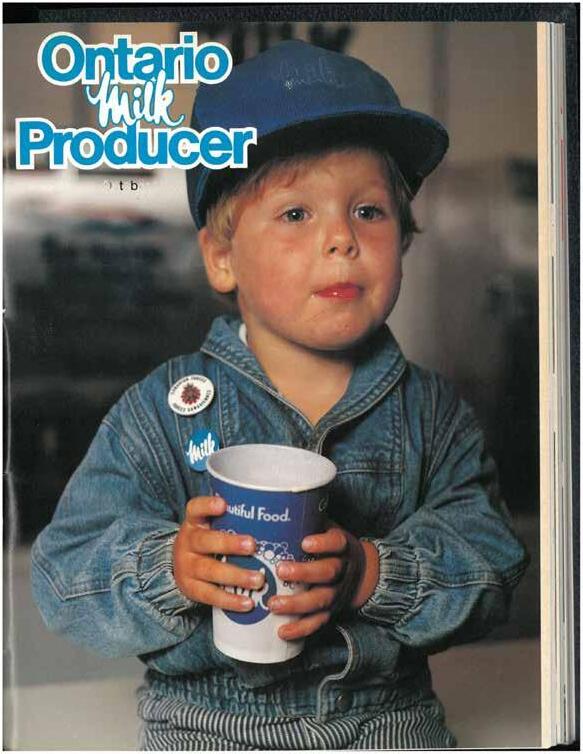
• FEBRUARY 2024 • WWW.MILKPRODUCER.CA 46
BACK40: A LOOK BACK IN MILK PRODUCER MAGAZINE HISTORY

Dundas
Optimum
Penner
800-461-9333
Dortman
Partner
Tara
Mount
Ron’s
Lindsay
For the life of your dairy ™ Contact Your BouMatic Dealer Today!
Agri-Systems
613-652-4844
Brinston
Agri
Vallee 705-647-5040
Belle
Farm Services
Blumenort
204-326-3781
Bros.
800-265-3435
Strathroy-Salford-Dunnville Wellesley
Ag Services
Forest 519-934-2343 877-349-3276
Bearings Equipment Sales
705-878-4515 NEXT GENERATION ROTARY The BouMatic Xcalibur rotary is highly regarded for its quality, comfort, and reliability. The Next Generation Rotary features improved cow comfort with a lower profile bail and better unit alignment. Redesigning of the cabinet and changes to the serviceability of the rotary will bring the operator’s comfort of ownership to a new level. With sizes from 40 to 150 stalls. To learn more about how you can milk more cows with less labor and increased performance, visit us at BouMatic.com/Xcalibur2.0

Your Road Map to Profitability







Profits have never been more challenging to attain. With EastGen’s solutions-based programs and trained staff, we will help you navigate your way to profitability every step of the way. We know we can turn your expenses into investments leading to bigger profits!
• Make the healthy choice for your herd with Immunity+®
• Achieve advanced reproductive & herd health management solutions with ai24®
• Define your farm economics & genetic needs with Semex Works™
• Better manage unwanted haplotype risks with OptiMate™
• Make the most of your herd inventory management with Elevate®
Ask your EastGen rep how you can achieve greater profitability with EastGen’s exclusive solutions-based programs and support!




7660 Mill Road, Guelph, ON N1H 6J1 ph: 1-888-821-2150 www .eastgen.ca
PROFIT Your Destination














 JEANLU A2P2 GLORY (VG-87 2yr)
Valiant Dairy Genetics, ON
ROSE VEGA A2P2 JIANNA (VG-86 2yr)
Rose Vega Farm, ON
JEANLU A2P2 GLORY (VG-87 2yr)
Valiant Dairy Genetics, ON
BOKMA A2P2 DIXIE (VG-86 1yr)
JEANLU A2P2 GLORY (VG-87 2yr)
Valiant Dairy Genetics, ON
ROSE VEGA A2P2 JIANNA (VG-86 2yr)
Rose Vega Farm, ON
JEANLU A2P2 GLORY (VG-87 2yr)
Valiant Dairy Genetics, ON
BOKMA A2P2 DIXIE (VG-86 1yr)

































































































